CORSON, BENJAMIN F. (1842-1905). Private, 139th New York Infantry, Company A. A New Yorker by birth, Corson enlisted at Brooklyn as a private on August 28, 1862, and mustered into the 139th New York on September 9. As per his obituary in the Brooklyn Daily Eagle, he was wounded several times, the worst of which was a chest wound caused by a flying splinter from a tree that was split by a cannon ball. He mustered out on July 19, 1865, at Richmond, Virginia. His brother, Isaac Corson (see), also served with the 139th Regiment.
Civil War Bio Search
Corson’s obituary notes that he was a wholesale fish dealer in Sheepshead Bay and Coney Island for forty years and had supplied the hotels there for twenty-five years. The census of 1880 confirms that he was a fish dealer in Gravesend, Brooklyn. In 1893, his application for an invalid pension was granted, certificate 863,101.
Together with his brothers and half-brothers (named Lundy), the family-owned business, Lundy Bros. fish market, was a predecessor to the famous eatery opened by descendants, that achieved landmark status. After his mother, Ruth Lundy, died in 1894, her obituary in The World stated that she and her large extended family were a major presence in Sheepshead Bay where almost all still lived and were well-to-do. (Benjamin had 10 children and his brother Isaac had 11.) As per the census of 1900, he was still working as a fish dealer.
An article in the Brooklyn Daily Eagle on February 7, 1904, states that Corson had been installed as sergeant major of the Moses F. Odell Post #443 of the G.A.R.; he was one of the founders of that post. In addition, he was an organizer of the Coney Island Volunteer Fire Department, serving as one of its trustees until its disbandment. Corson was also a founder and member of the Sheepshead Bay Methodist Episcopal Church; that church’s reverend and the chaplain of the 139th Regiment’s Veteran Association officiated at his funeral. He last lived in Coney Island, Brooklyn, at Ocean Parkway and Sheepshead Bay Road. His death was attributed to cancer of the tongue, an affliction that he suffered for eighteen months. He was survived by his wife and four children. His half-brother, Frederick Lundy, was an alderman.
A letter to the War Department, written in 1905, notes that his name was Benjamin F. Corson; the middle initial “T.” was incorrectly used on some documents. Josephine Demarest Corson, who is interred with him, applied for and received a widow’s pension shortly after his death in 1905, certificate 654,025. Section 135, lot 27263, grave 2277.
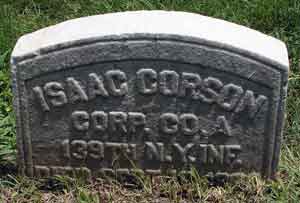
CORSON, ISAAC (1846-1898). Corporal, 139th New York Infantry, Company A. A New Yorker by birth, Corson enlisted as a private on August 19, 1862, and mustered into the 139th New York on September 9. According to a descendant, he was at the Battle of Crump’s Cross Roads at Bottom’s Bridge, Virginia, on July 3, 1863, where he was wounded in the right thigh by a gunshot and then treated at McClelland Hospital at Fort Monroe, Virginia. However, the muster roll shows that he was treated at Chesapeake Hospital in August 1863. He returned to service on September 21, and was promoted to corporal on May 1, 1865. On June 19, 1865, he was discharged at Hart’s Island, New York Harbor. His brother, Benjamin (see), also served in the 139th.
A fisherman after the War, he was later employed as a dyer clerk at the Corson Dye Factory in Staten Island, as verified by the census of 1870. Returning to work in Brooklyn as a fisherman who chartered boats in Sheepshead Bay, the Corson brothers and stepbrothers (their mother married Frederick Lundy after their father died from being struck by lightning on a fishing trip) started the famous Lundy Bros. fish market, a predecessor to the landmark restaurant opened by family descendants in 1926. He received an invalid pension in 1875, certificate 137,618. According to the census of 1880, he was a fisherman.
An article in the Brooklyn Daily Eagle on September 17, 1893, described a lively annual dinner held at Doyle’s Pavilion in Brooklyn that reunited the 139th; out of the 1,468 who served, only 145 men were alive including Isaac and Benjamin Corson. He last lived at Dooley Street and Emmons Avenue in Brooklyn. According to his descendant, he died after a fishing-related incident; other documents note the cause of death was phthisis. Agnes Surman Corson, who is interred with him, applied for and received a widow’s pension in 1898 under certificate 475,142. He was also survived by three children. Section 135, lot 30010, grave 155.
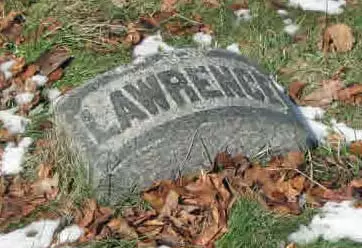
CORTELYOU, LAWRENCE VOORHEES (1837-1896). Acting assistant surgeon, Department of the East. Born into a prominent family in Brooklyn, his father Jacques served with the 64th New York Militia during the War of 1812. The family first lived in the Old Stone House, an historic dwelling built in 1699 on 3rd Street between Fourth and Fifth Avenues, which played a key part in the Battle of Brooklyn; the house was sold to the Cortelyou family in the latter part of the 18th century. Jacques Cortelyou sold that house to a real estate developer, Edwin Litchfield, after his wife died in 1852 and the family moved to Dutchess County.
Lawrence Cortelyou was a graduate of Yale, class of 1859. In 1861, after some foreign travel, he continued his studies in New York City and received a medical degree from Bellevue Hospital Medical College in 1864. On April 23, 1864, he was appointed an acting assistant surgeon for the Department of the East and ordered to report to Fort Columbus in New York Harbor. Cortelyou was then sent to the U.S. General Hospital at Elmira, New York, effective July 8, 1864, a contract that was terminated on August 26 on account of ill health. According to the Biographical Records of Yale Graduates, he was also head of a dispensary in New York.
Cortelyou then resumed his medical practice for ten years in Rye, Brooklyn, and Poughkeepsie, New York, but upon the death of his father, he took over control of his family’s real estate interests in Brooklyn that included land in Gowanus and around Prospect Park. The sale of this property brought him great wealth. His personal life was marked by tragedy after his April 1865 marriage to Ida Tuttle. The young couple spent several months traveling in Europe but on the return trip home the boat lurched violently and Mrs. Cortelyou dislocated her hip, eventually resulting in her death in Rye, New York, in July 1866. Although he remarried, he remained haunted by the loss of his first wife.
In civilian life, he was a member of the Brothers of Unity and the Nautilus Boat Club. He also belonged to the Holland Society whose members traced their ancestry through the male line to early Dutch settlers in America before 1675. After suffering with a long illness, he leapt to his death from a third floor window in his Brooklyn home on August 5, 1896. He was survived by his second wife, Caroline Townsend. Section 64, lot 2473.
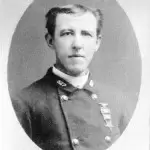
CORTELYOU, WILLIAM V. H. (1843-1887). Private, 12th Regiment, New York State Militia, Company D; 9th New York Infantry, Company B. Born in Lebanon, Ohio, Cortelyou was employed as a clerk. He was 5′ 11″ with a light complexion, gray eyes and brown hair. After serving for three months with the 12th Regiment beginning in April 1861, he re-enlisted at New York City on August 10, 1861, and mustered into the 9th New York (also known as Hawkins’ Zouaves) that day. He incurred a gunshot wound through the right knee at the Battle of South Mills in Camden, North Carolina, on April 19, 1862, necessitating amputation of the leg ten inches above the knee, and was taken as a prisoner of war for about a week. After being paroled, he was sent to Fortress Monroe, Virginia, where he was hospitalized for three months. He was discharged for disability at the Ladies Home United States General Hospital in New York City on May 20, 1863. In September 1863, his application for an invalid pension was granted, certificate 24,003. The government issued him an artificial leg on October 5, 1863. The pressure was painful and on July 11, 1870, he applied for a replacement.
As per the Brooklyn Directory for 1870-1873 and the New York City Directory for 1877, he worked at the Custom House. He was a member of G.A.R., first belonging to Rankin Post #10 and then became a charter member of U. S. Grant Post #327 in Brooklyn. Cortelyou last resided at 353 Schermerhorn Street in Brooklyn. His death was attributed to cystic degeneration of the kidneys. The first pension application of his widow, Elizabeth Cortelyou, was rejected, the examiners not finding “extreme destitution,” since despite frequent epileptic seizures, she was able to earn $1.50 weekly by sewing, and the G.A.R. post paid her rent. Upon appeal by the G.A.R, she was granted a pension in 1887, certificate 255,121. Section 16, lot 11990.
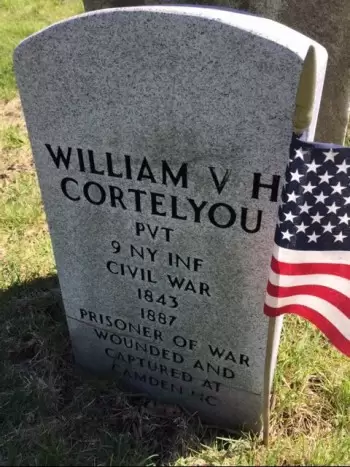
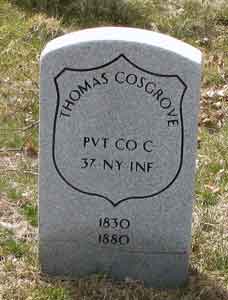
COSGROVE, THOMAS (1830-1880). Private, 37th New York Infantry, Company C. Born in Ireland and a picture-frame maker according to the census of 1860, he enlisted as a private at New York City on May 9, 1861, and mustered into Company C of the 37th New York on June 7. Cosgrove was 5′ 7½” tall with gray eyes, brown hair and a fair complexion. He was dropped from the rolls on September 5, 1862, per General Order 92. Although he applied for an invalid pension on March 4, 1863, application 12,497, it was never certified. The census of 1870 indicates that he was a sexton; the U.S. Mortality Table for 1880 shows that he was a clerk. In 1892, his widow received a pension, 380,163. He last resided at 199 Smith Street in Brooklyn. Cosgrove died from diabetes. Section 15, lot 17263, grave 379.
COSTER, JOHN HENRY (1835-1895). Major by brevet; colonel, 181st New York Infantry; captain, 1st New York Infantry, Company F; private, 7th New York Infantry, Company K. An architect before the Civil War and a New York City native, John Henry Coster began his long military career as a private with Company K of the 7th New York State Militia on April 26, 1861. He became captain of Company F, 1st New York Infantry, on August 28, 1861, and served as an aide-de-camp to Major General Irwin McDowell. Coster was severely wounded in the jaw and captured at the Battle of Glendale, Virginia, on June 30, 1862 (where he was left dying on the field), and was held at Libby Prison in Richmond for several weeks. He was exchanged in July 1862 prior to his discharge for disability in March 1863.
After Coster was appointed colonel of the 181st New York Infantry in 1864, his authority was revoked because no men were recruited. His gallantry on the battlefield was recognized on March 7, 1865, when he was promoted by brevet to captain, “for gallant and meritorious services during the action of Glendale,” and again on March 13, 1865, when he was brevetted to major “for gallant and meritorious service during the War.”
Coster returned to service on September 20, 1865, and was commissioned first lieutenant of Company H of the 6th California Infantry until October 25. On November 18, 1865, he was commissioned as a first lieutenant in Company I of the 7th California Infantry, mustering out on March 31, 1866, at San Francisco, California. Afterwards, he was a captain of the 1st Arizona Infantry, as of April 1 until June 13, 1866. He was commissioned first lieutenant of the 30th United States Infantry in March 1867 and transferred to the 8th United States Cavalry in December 1870. Coster retired in 1882.
Coster was a real estate dealer and was a long-time member of the American Jockey Club, seving as its secretary in 1880. He resided in New York City, at 66 East 56th Street, at the time of his death. In 1896, Emily Olliffe Coster filed for a widow’s pension. A letter signed by Coster, dated April 10, 1873, declining an invitation to dine with associates of the Engineering Corps and Company K of the 7th National Guard, was offered for sale on ebay in 2019. Section 157, lot 14301, grave 14.
COTTER, BLENNERHASSETT (or BLENERHASSETTS) (1840-1883). Quartermaster sergeant, 11th New York Cavalry, Company E; private, 71st Regiment, New York State Militia, Company C. Originally from Ireland, Cotter served for three months with the 71st Regiment when it was activated in 1861. He re-enlisted on May 28, 1862, at New York City, returned to the 71st Regiment, now part of the National Guard, and mustered out three months later on September 2 at New York City. On September 29, 1862, Cotter mustered into the 11th New York Cavalry as private having previously re-enlisted at Washington, D.C., on June 29. He was promoted to quartermaster sergeant on September 30, and mustered out at Memphis, Tennessee, on June 12, 1865. He may also have served using the aliases John Costillo or Francis Tierney. If he served as Tierney, then he was incarcerated at Missouri State Penitentiary at some point during his service.
On May 19, 1868, he filed a petition to become a naturalized citizen. According to the census of 1880, he lived in Loda, Illinois, where he was employed as a bookkeeper. He last lived at 98 East 10th Street in Manhattan. Cotter succumbed to phthisis (tuberculosis). In 1890, James Chapman, guardian, applied for a pension for a minor, application 485,394, but there is no certificate number listed. Section 2, lot 5499, grave 1672.
COTTON (or COLTUN), CHARLES HENRY (1845-1938). Private, 23rd Regiment, New York State National Guard, Company B. Born in Brooklyn, Cotton served as a private in the 23rd Regiment in 1863 when it was activated for 30 days. Remaining active in military affairs, he was a member of the 23rd Veterans Association who attended the annual reunion in April 1878, and was a member of the Winchester Post #197 of the G.A.R. Through his involvement in the Grand Army of the Republic, he was appointed as a member of the New York State’s Special Committee on Patriotism and Civics in our Public Schools.
The 1877 New York City Directory lists him as a stationer at 69 Williams Street; he lived at 196 Greene Avenue in Brooklyn. A Republican, he was appointed an Election Commissioner in 1882; he served in that position for eleven years. Cotton was also a member of the Kings County Republican General Committee for seventeen years. The New York City Directory for 1891-1892 lists him as a stationer whose company bore the name of Charles H. Cotton & Company and was located at 69 Williams Street; during those years, he lived on Greene Street in Brooklyn. A member of the Lincoln Club, his name was listed as among those who attended a lecture on “The Exiles of Siberia,” as reported in the Brooklyn Standard Union on December 11, 1888; that article noted that the speaker appeared dressed as a prisoner, manacled and dressed lightly, to highlight the harsh conditions under the czars.
At the time he ran for statewide election, Cotton was a wholesale stationer whose business was at 33-35 Liberty Street in Manhattan. His biography in the Brooklyn Standard Union on November 1, 1898, when he was a Republican candidate for the State Assembly, noted that he had lived at his Greene Avenue address for about twenty-five years and identified his business, civic and political affiliations; that sketch cited his popularity as a public official. Cotton was elected to the New York State Assembly from 1899- 1902, when he was the chairman of the committee on military affairs, lost his re-election bid in 1902, and returned to the legislature in 1905.
Cotton maintained his interest in the Civil War throughout his life. On April 19, 1926, he was cited in an article in the Brooklyn Standard Union as being on the committee of G.A.R. members who were involved in the planning of the dedication of Grand Army Plaza in Brooklyn and the 60th anniversary of the aforementioned organization; veterans from all wars would be invited to attend that celebration. In addition, he was pictured with other surviving veterans at age 85 and appeared in a photo sitting in an open car with three other Civil War veterans in a parade in 1931.
As per his obituary in the Brooklyn Daily Eagle, he was one of the last surviving members of the Grand Army of the Republic and the last surviving member of Lincoln’s New York City funeral escort. That obituary notes that he read the newspaper every day, marched in many Memorial Day parades, until two years before his death walked daily to Borough Hall, and he remained mentally acute. His obituary in the New York Evening Post confirms his Civil War service as well his political duties and business career. He last lived at 238 Willoughby Avenue in Brooklyn. His death was attributed to carditis (heart disease.) He was survived by a daughter. Section 78, lot 8387.
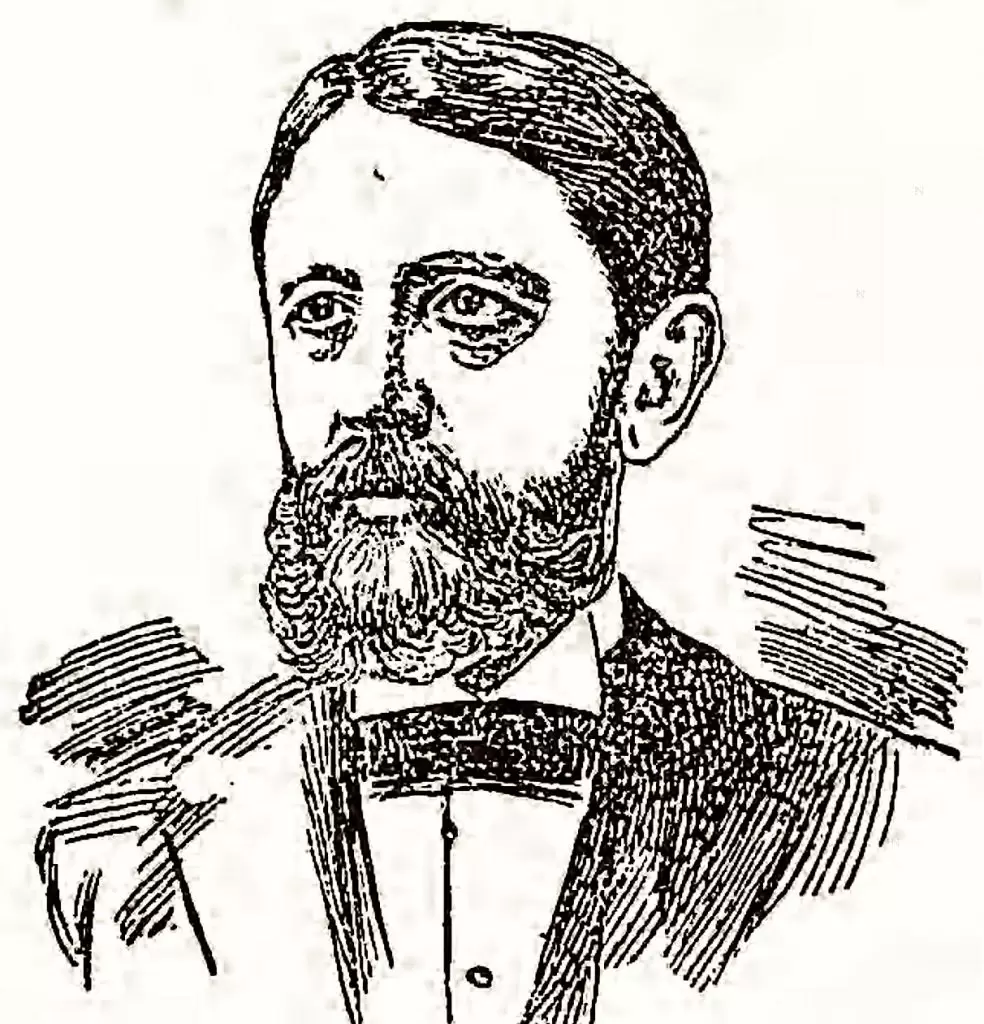
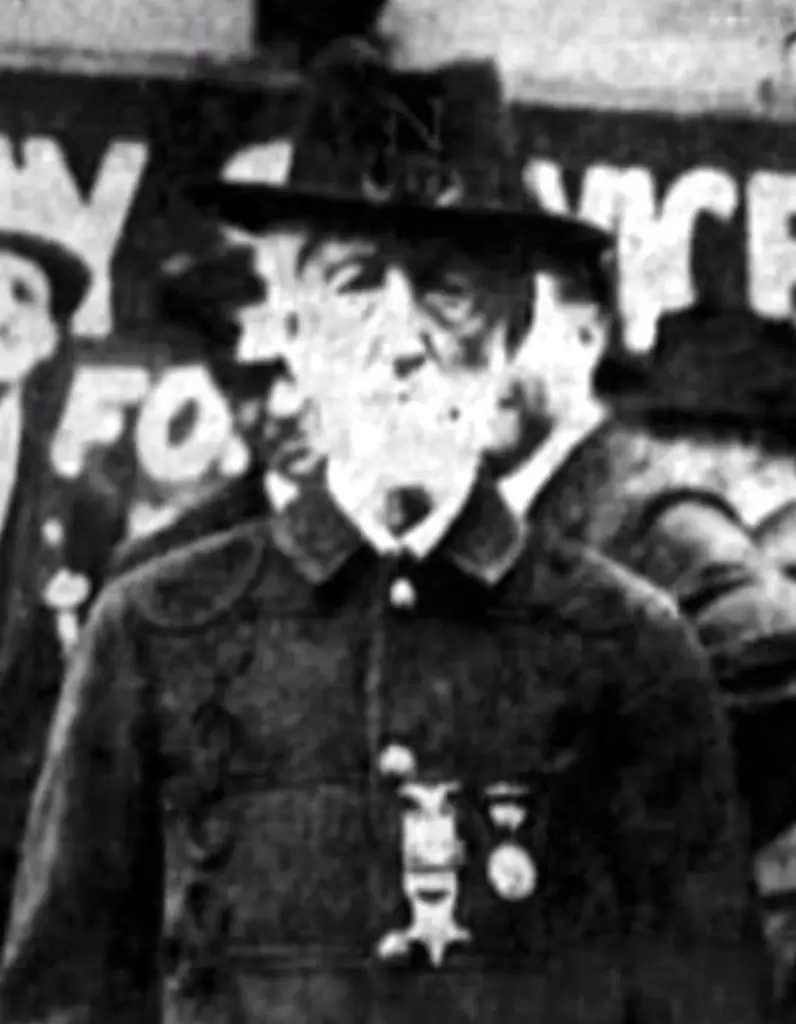
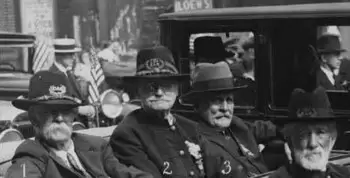
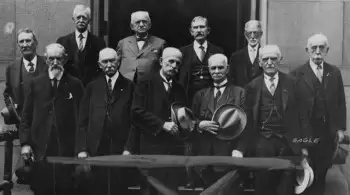
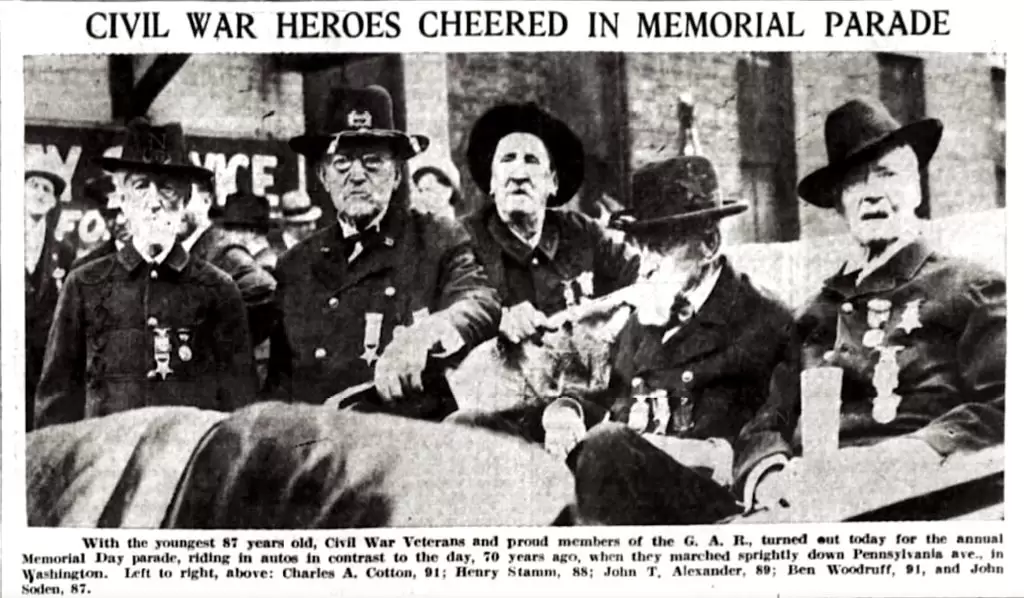
COTTON, EDWIN (1829-1885). First sergeant, 162nd New York Infantry, Company I. Born in Manchester, England, Cotton enlisted as a private on September 4, 1862, at New York City, and mustered into the 162nd on September 25. He was promoted to corporal on October 18, 1862, served in the Mississippi area, and was listed as absent and sick in the Marine Hospital at New Orleans, Louisiana, on December 31, 1863. Cotton rose to sergeant at some point before his hospitalization and was promoted to first sergeant on April 20, 1865, prior to mustering out with his company at Savannah, Georgia, on October 12, 1865. The New York State record of his service incorrectly lists his name as “Colton.” After the War, he was employed as a brush maker. His last residence was 337 West 20th Street in Manhattan. He died from cystitis. Margaret Cotton applied for and received a widow’s pension, certificate 294,126. Section B, lot 8100, grave 734.
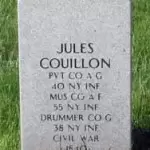
COUILLON (or COUILLOU), JULES (or JULIUS) E. (1840-1906). Musician, 55th New York Infantry, Companies A and F; 38th New York Infantry, Company G; private, 40th New York Infantry, Companies A and C. A native of Switzerland, he was an apprentice to his father as a watch-spring maker in 1860. He enlisted at Staten Island as a musician on August 1, 1861, and mustered into Company A of the 55th on August 28 where he served as a drummer. Subsequent to an intra-regimental transfer to Company F on October 1, 1862, he was transferred to the 38th New York on December 21, 1862. On June 3, 1863, he was transferred into the 40th New York, also known as the Mozart Regiment, where he was reduced to the rank of private and served until he mustered out on August 28, 1864.
Couillon is listed as a jeweler in the Brooklyn Directory for 1873-1876; during those years, he lived at 181 Van Dyke Street.The Brooklyn Directory for 1888-1890 shows that he was a jeweler; the census of 1900 notes that he made watch cases. He last resided at 568 54th Street in Brooklyn. Couillon died from tuberculosis. Section 15, lot 17263, grave 1680.
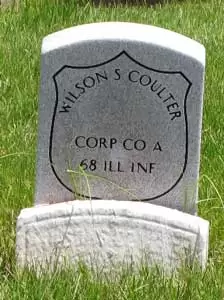
COULTER, WILSON S. (1840-1896). Corporal, 68th Illinois Infantry, Company A; private, 14th Illinois Infantry, Companies F and I; Veteran Battalion, 14th and 15th Illinois Infantry, Company F. Ohio-born, Coulter was a farmer who lived in Jacksonville, Illinois, when he enlisted as a corporal on May 27, 1862. He mustered into the 68th Illinois on June 23, 1862, and mustered out on September 26, 1862, at Camp Butler, Springfield, Illinois. Coulter also served in the 14th Illinois Infantry and the Veteran Battalion (formed from the 14th and 15th Regiments), from December 23, 1863, until June 21, 1865.
In 1880, Coulter was still living in Jacksonville, then relocated to Galveston, Texas, where in 1882, he worked for a liquor distributor. The Veterans Schedule of 1890 notes that he was living in Galveston, confirms his service in the 14th Illinois, and reports that he was incarcerated at the infamous Andersonville Prison in Georgia for eight months. (Many soldiers from the 14th and 15th Illinois were captured in October 1864 by Confederate General John B. Hood and Coulter might have been imprisoned at that time.) He applied for and was granted an invalid pension in 1890, certificate 799,424. Coulter last lived at 257 West 31st Street in Manhattan. His death was due to heart disease. Lizzie Coulter applied for and received a widow’s pension shortly after his death in 1896, certificate 474,143. Section 135, lot 14964, grave 702.
COURT, JAMES (1835-1883). Private, New York Union Coast Guard, Company C; 99th New York Infantry, Company I. A New York City native, he enlisted at New York City as a private on January 9, 1861, and mustered into Company C of the New York Union Coast Guard on June 14. On September 1, 1861, he transferred into the 99th New York Infantry. He was discharged on September 8, 1864, at New Berne, North Carolina. He last lived at 412 East 17th Street in Manhattan. Court died from heart disease. Section 14, lot 4969, grave 270.
COVINGTON, JOHN R. (1833-1866). Private, 145th Pennsylvania Infantry, Company E. Covington enlisted as a private on September 19, 1863, mustered into his company the same day, and was discharged on December 8, 1863. He last resided at 292 Gold Street in Brooklyn. Section 121, lot 7639, grave 103.
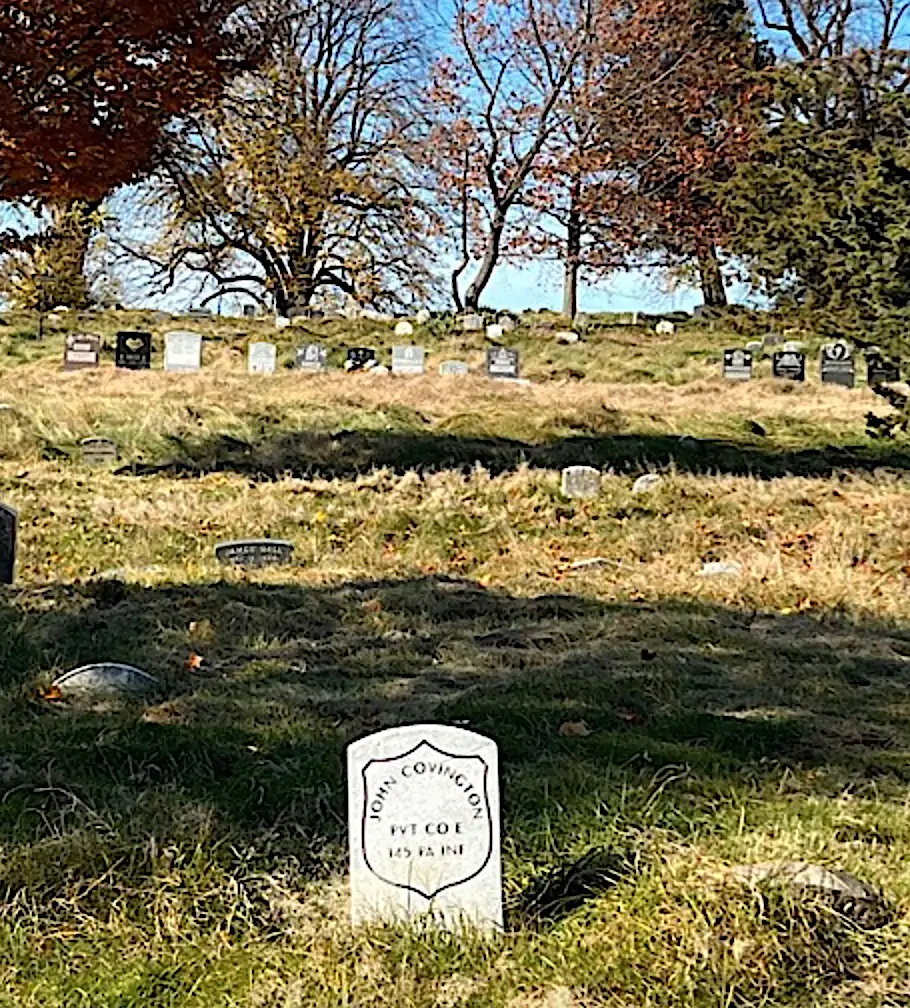
COWDREY (or COWDRY, CANDREY), EDWARD A. (1834-1865). Captain, 95th New York Infantry, Company K; second lieutenant, 17th New York Infantry, Companies C, I, G, and E. A native New Yorker and City resident, Cowdrey enlisted there as a private on October 8, 1861, and mustered into Company C of the 17th New York the next day. He underwent a number of intra-regimental company transfers, the first to Company I on July 15, 1862, when he was promoted to second lieutenant. He transferred to Company G on January 1, 1863, to Company E on May 14, 1863, and mustered out on June 2, 1863, at New York City. Re-enlisting at New York City as a first lieutenant on June 24, 1864, he was commissioned the next day into the 95th New York, and promoted to captain on December 24 of that year. Wounded at Hatcher’s Run, Virginia, on March 31, 1865, he died on May 7 in Georgetown, D.C., of the wounds he received in battle. It appears that he was a relative of Frank Cowdrey (see) who also served as a captain of the 95th New York earlier in the War. His biography is listed in William Swinton’s History of the Seventh Regiment (1870); it is unclear when he served in Company F. Section 107, lot 1683.
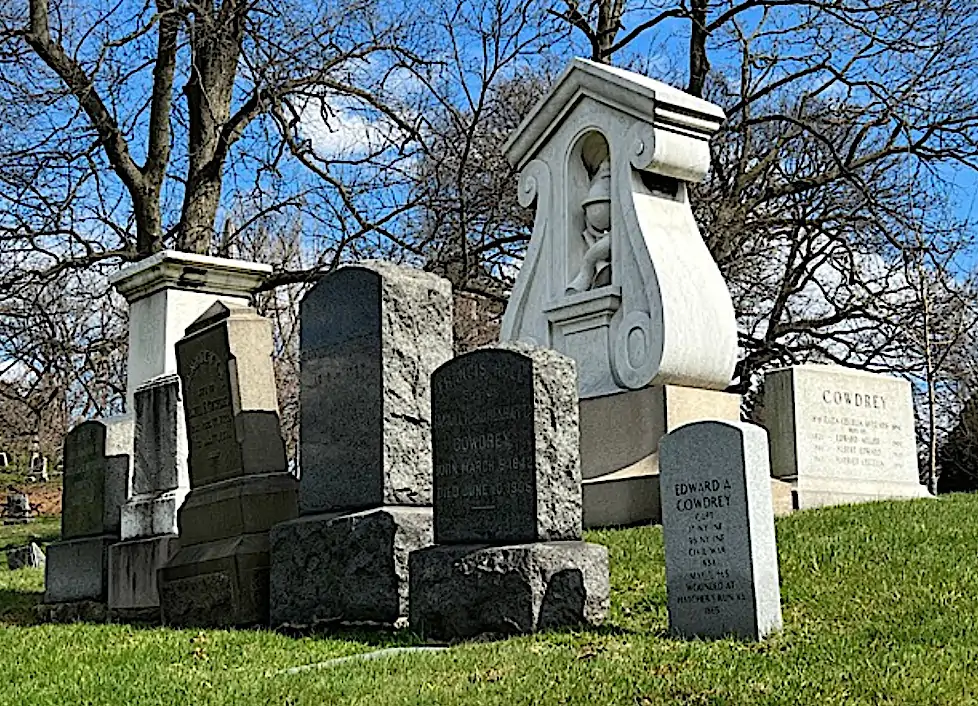
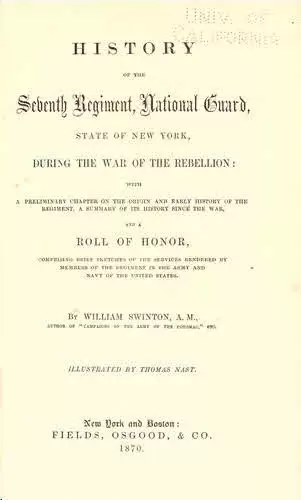
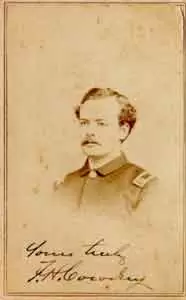
COWDREY (or COUDREY, COWDRY), FRANK HULL (1842-1905). Lieutenant colonel and major by brevet; captain and assistant adjutant general, United States Volunteers; captain, 95th New York, Companies G and K; private, 7th Regiment, New York State Militia, Company F. A New Yorker by birth, Cowdrey was a lawyer at the time he entered service. He was 5′ 8″ tall with hazel eyes, brown hair and a light complexion. He first served as a private in the 7th Regiment in 1861 for 30 days before he re-enlisted as a first lieutenant at New York City on December 22, 1861, and mustered into Company G of the 95th New York four days later. Cowdrey transferred to Company K on March 6, 1863, and was promoted to captain six days later.
Cowdrey was part of General Abner Doubleday’s staff as assistant commissary of musters during the Gettysburg Campaign in June-July 1863. Doubleday commended him for his distinguished actions and wrote, “The rebels did not seem to appreciate my humanity in sending out to bring in their wounded, for they opened a savage fire against the stretcher-bearers. One shell burst among us, a piece of it knocked me over on my horse’s neck, and wounded Lieutenant Cowdry of my staff.” According to the muster rolls, he was absent on detached service from August-October 1863, December 1863, and February 29-April 30, 1864. Upon his discharge for promotion on April 20, 1864, he was commissioned into the United States Volunteers Adjutant General’s Department as a captain and assistant adjutant general to General Hayes. Brevet Major General S. W. Crawford wrote a recommendation for Cowdrey’s promotion to major by brevet on April 28, 1865, “for personal courage during the campaign from the Wilderness to Petersburg, and for coolness and daring in riding forward to the skirmish line of his brigade on the 6th of February, when he was very severely wounded…” The advice was honored when he was brevetted major for “gallant and meritorious service during the War,” and lieutenant colonel “for faithful services and conspicuously gallant bearing to date from March 13, 1865.” He mustered out on September 19, 1865.
In May 1867, he received a Bachelor of Law degree from Columbia University; in 1868, Cowdrey is listed as an officer and graduate in a book published by Columbia. The New York City Directory for 1876-1878 lists him as a lawyer at 67 Wall Street. He applied for an invalid pension in 1879, which was granted under certificate 109,257. According to the census of 1880, he was a lawyer living in New Rochelle, New York. As per the Brooklyn Directory for 1885-1886, he was working as a lawyer at 33 Pine Street and lived in New Rochelle. Although his name appears on the Veterans Schedule of 1890, there is a notation that he wasn’t reached by the enumerator of that survey. He was likely a relative of Edward A. Cowdrey (see) who succumbed to battlefield injuries. After 1902, he resided at the U.S. Home for Disabled Soldiers in Hampton, Virginia, but died at Phoebus, Virginia. Section 107, lot 1683.
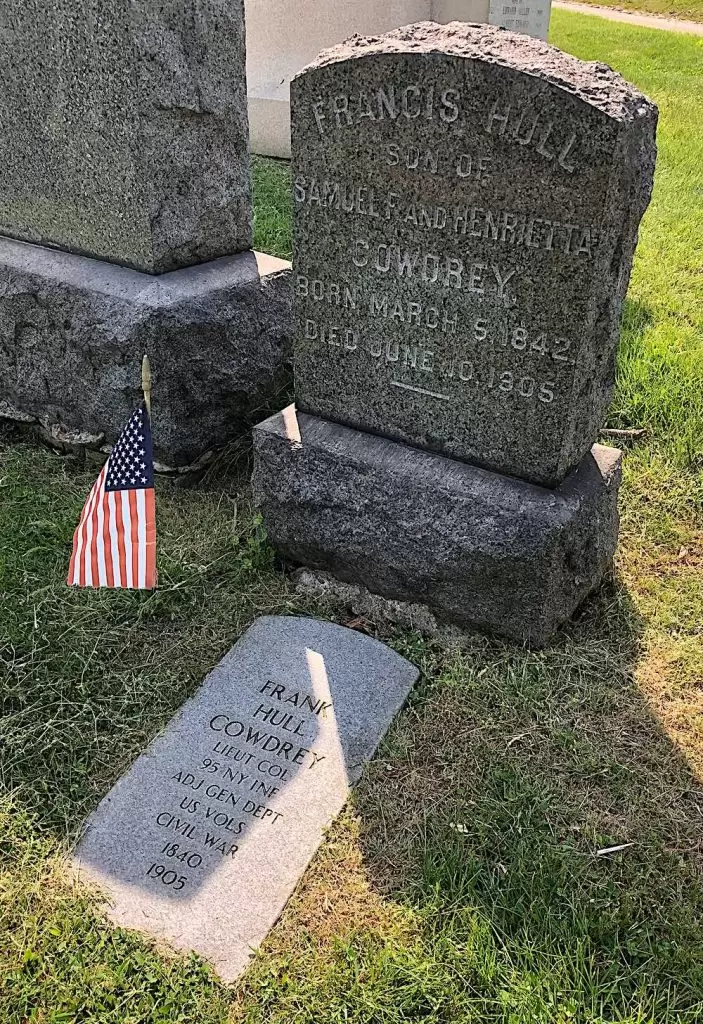
COWEN, JOHN (1842-1919). Sergeant, 102nd New York Infantry, Company I. Of Irish birth, Cowen enlisted at New York City as a corporal on October 15, 1861, mustered into the 102nd New York nine days later, and mustered out on an unspecified date. Subsequently, he re-enlisted on December 30, 1863, mustered into the 102nd New York for a second time, was promoted to sergeant during his service, was reduced to ranks on July 12, 1864, and mustered out on July 21, 1865, at Alexandria, Virginia. In 1879, his application for an invalid pension was granted, certificate 442,027. The Veterans Schedule of 1890 confirms his military service, notes that he suffered a gunshot wound to the left leg on August 9, 1862, at the Battle of Cedar Mountain, Virginia, that he was captured by rebels on January 29, 1865, and that he suffered a double rupture at that time. Remaining active in military affairs, Cowen was a member of Ulysses S. Grant Post #327 of the G.A.R. His last residence was 126 Vanderbilt Avenue, Brooklyn. Cowen died from arteriosclerosis. Section 79, lot 9793.
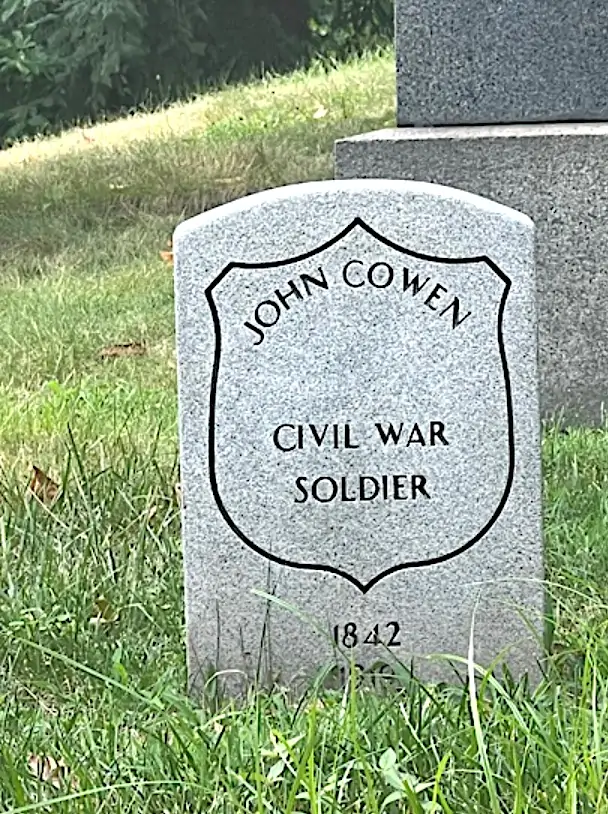
COWEN, ROBERT W. (1835-1866). Private, 173rd New York Infantry, Company A. A native of New York, Cowen enlisted at Brooklyn as a private on August 30, 1862, mustered into the 173rd New York on October 30, and deserted shortly thereafter on November 10 at Rikers Island, New York Harbor. He last resided on Third Avenue in Brooklyn. His death was caused by consumption. Originally interred on November 18, 1866, his remains were moved to their present site on July 13, 1871. Section 86, lot 18066, grave 43.

COWPER, GEORGE (1839-1918). Private, 151st New York Infantry, Company B; Veteran Reserve Corps, 160th Company. After enlisting as a private at Niagara, New York, on August 30, 1862, he mustered into the 151st New York on October 22. Cowper transferred into the 160th Company, Veteran Reserve Corps, 2nd Battalion, on April 24, 1864, from which he was discharged at Point Lookout, Maryland, on June 27, 1865. He last lived at 410 Fairmount Avenue in Jersey City, New Jersey. His death was attributed to nephritis. Section 19, lot 4115.
COX, JAMES F. (also known as JOHN S. FORRELL or FARRELL) (?-1915). Rank unknown, 9th New York Infantry; second class fireman, United States Navy. Cox was born in Brooklyn. As per his obituary in the Brooklyn Standard Union, which confirms his Civil War service, he first served in the 9th Regiment, New York Infantry, also known as Hawkin’s Zouaves. He served with them at the Battle of Roanoke Island in February of 1862 and then was transferred to the United States Navy in 1864. His pension index notes his alias of James S. Farroll, which might be Farrell. His obituary indicates that he served on the USS Susquehanna under Admiral Farragut and was at the Battle of Mobile Bay.
After the war, he returned to Brooklyn. He was employed by the undertaking firm of Ferdinand Selle, at 654 Fifth Avenue for forty-one years as a general assistant. His application for an invalid pension was approved; that document only lists his service in the Navy and shows service on the USS Kathadin, Susquehanna, Potomac, North Carolina and Vermont. Cox was a member if the Church of St. John the Evangelist at 21st Street and Fifth Avenue. He last lived at 704 Sixth Avenue in Brooklyn. At the time of his death, he had been ill for two years. Selle, where he worked for so many years, is listed as his undertaker. Cox was survived by his widow, Elizabeth Switzer Cox, four sons, two daughters and six grandchildren. His widow applied for and was awarded a widow’s pension. His wife and her father, Martin Switzer (see), are buried with him. Section 115, lot 4196, grave 550.
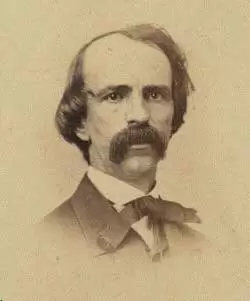
COX, SAMUEL SULLIVAN (1824-1889). Congressman. A native of Zanesville, Ohio, his grandfather, James Cox, was a Congressman from New Jersey. After attending Ohio University, Cox graduated from Brown University in 1846, then practiced law in Zanesville before becoming owner and editor of the Statesman newspaper in Columbus, Ohio. A supporter of Stephen Douglas and a Democrat, he was elected to Congress from Ohio in 1856, supporting conciliation between North and South.
During the Civil War, Cox was a leader of the Democratic opposition in the House, denouncing President Lincoln’s suppression of freedoms including free speech, suspension of habeas corpus, and military trials of civilians. Cox favored a limited war to restore the Union without subjugating the secessionist states. He was opposed to the trend toward centralization of power and was non-committal on the issue of emancipation. In January 1863, he delivered an address in Ohio, “Puritanism in Politics,” which was published. In 1864, he was defeated for re-election, moved to New York City, and resumed the practice of law. In 1865, he wrote Eight Years in Congress, From 1857-1865.
In 1868, Cox was re-elected as a Democrat for two terms, then lost but returned to Congress in 1873, and served another six terms. During the 1874-1876 session, he was named chair of the Banking and Currency Committee then elected Speaker pro tem when Speaker Michael Kerr took ill. He resigned in 1885 when President Grover Cleveland appointed him ambassador to the Ottoman Empire (Turkey). A year later, Cox gave up the post and returned to Congress for two more terms, in a special election after the resignation of Joseph Pulitzer, then representing New York for a total of twenty years, and serving as head of the Democratic Caucus in his last term.
Nicknamed “Sunset” early in his career as an editor, for his descriptive language and impassioned speaking style, he was an advocate for civil service reform and of westward expansion during his time in Congress after the Civil War. He was instrumental in the merger of the Life Saving Service with the U.S. Coast Guard and furthering the information base for the federal census. A friend of letter-carriers for his support of benefits and a 40 hour work week for U.S. Post Office Employees, the mail carriers raised $10,000 in 1891 for a statue in his honor at Tompkins Square Park in New York City and for a monument at Green-Wood. A regent of the Smithsonian Institution, he was a well known lecturer and man of letters authoring Three Decades of Federal Legislation (1885), A Search for Winter Sunbeams (1870), Arctic Sunbeams (1882) and many pamphlets.
He last lived at 13 East 12th Street in Manhattan. His death was attributed to pneumonia. President Grover Cleveland and General William Tecumseh Sherman were honorary pallbearers at his funeral. As per a notice of his death in the New York Herald, members of the Musical Mutual Protective Union adopted resolutions of condolence that were extended to his family; those resolutions thanked him for being a loyal champion and for his public service. An obituary in the Wayne County [Pennsylvania] Herald noted that there was a quiet movement for Cox to run for President in 1892, engineered by admirers in New York and in the far west. He died September 10, 1889; burial at the present location at Green-Wood was on May 27, 1890.
The statue of Cox, designed by Louise Lawson, was unveiled on July 4, 1891, and depicts him orating before Congress. The New York Times, in its critique of the statue, questioned whether it “will ever be greatly admired as a work of art” because his face and demeanor were “out of harmony” with his genial being. Nonetheless, 2,500 letter carriers came from as far away as New Orleans and Memphis to participate in the celebration honoring Cox. The monument in Tompkins Square Park lists 188 cities whose mail carriers contributed to the statue. The statue was moved to its current location in 1924 and was conserved in 1998. Section 29, lot 27123.
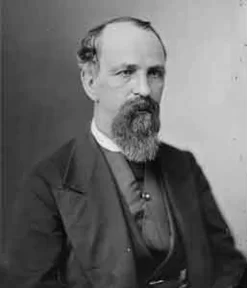
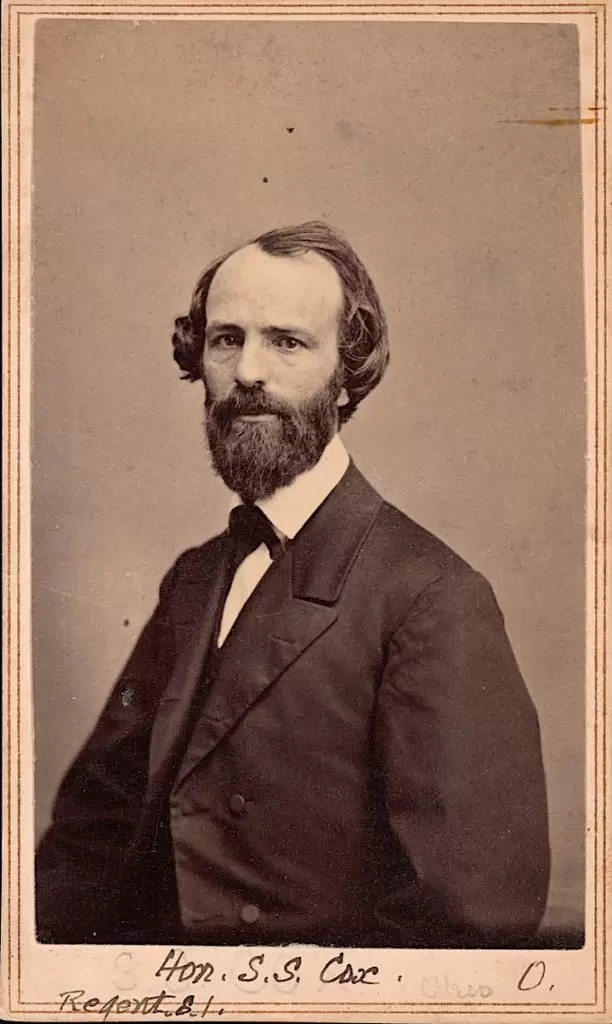
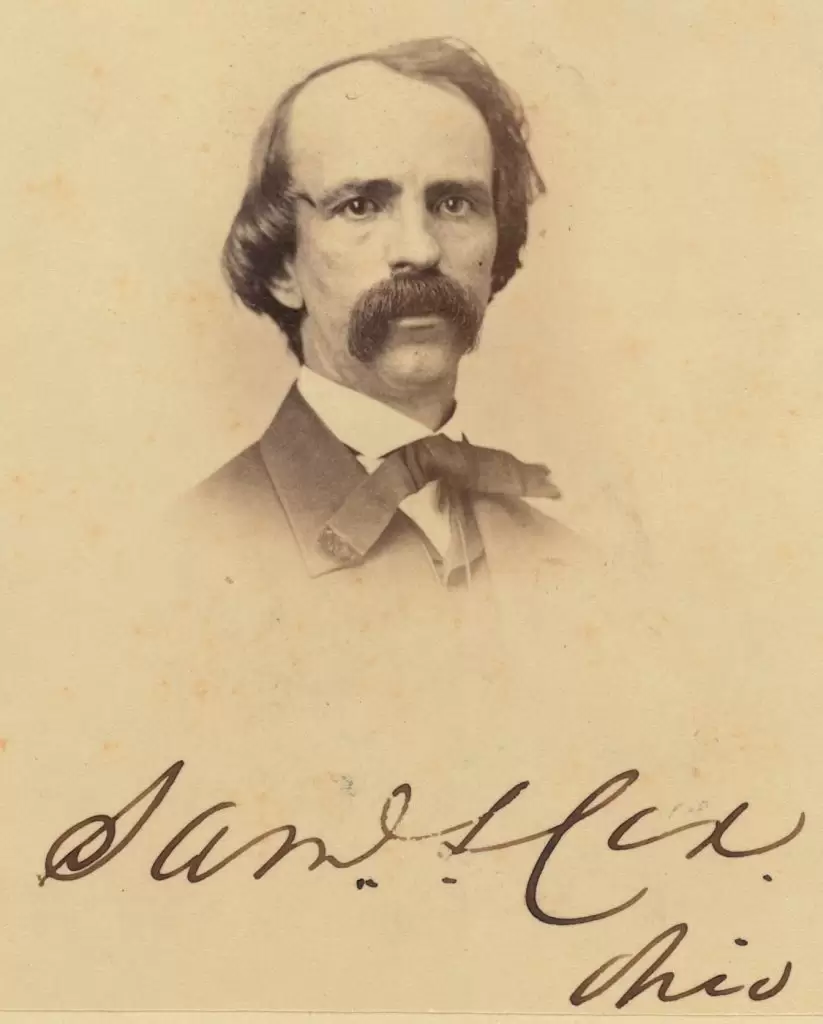

COX, TOWNSEND (1829-1905). Lieutenant, 22nd Regiment, New York State National Guard, Companies A and C. Cox, a native of Locust Valley, Long Island, traced his lineage to ancestors who bought land near Matinecock Point in 1663, making the Coxes one of Long Island’s oldest families. He married Anna Helme in 1856. During the Civil War, he enlisted as a corporal, rose to sergeant and served in the 22nd Regiment, New York State National Guard, Company A, for three months in 1862. When his unit was activated in 1863, he served as a lieutenant with the same regiment’s Company C for three months.
He is listed as a broker on Exchange Place in the New York City Directories for 1875-1876, 1876-1878, and the Phillips’ Business Directory for 1881-1882. Townsend Cox & Co. is listed as a brokerage on Exchange Place in the New York City Directories 1882-1883 and 1891-1892. A member of the Stock Exchange, Cox was the president of the Gold Board and New York City’s Commissioner of Charities and Correction. In addition, he was a founder and president of the Mendelssohn Glee Club, an all male chorus that began in 1866 and still performs today. He died in Atlantic City, New Jersey. Section 171, lot 3232.
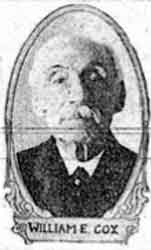
COX, WILLIAM EDGAR (1831-1921). Paymaster’s clerk, United States Navy. Born in Jersey City, New Jersey, Cox began work with the Nautilus Insurance Company (later renamed the New York Life Insurance Company) as an office boy in 1849. At the time, it had a total of six employees. In writing his remembrances in 1919, when he was in his late eighties, he described his duties at 68 Wall Street that included opening the safe, taking out the books and making himself useful from 9 a.m. to 5 p.m. As the company grew and relocated to Pine Street and Broadway, he began to write policies, often twenty-five or thirty a day in his own handwriting, which were then shipped to agents around the country. In 1857, the company was at 112 Broadway; he later reminisced about the camaraderie among the employees and his enjoyment of his job.
Cox temporarily left the firm when the Civil War began and received an appointment to the Navy on November 20, 1861, as a paymaster’s steward, at Portsmouth, New Hampshire. He was assigned to the USS Constellation and set sail for Europe, visiting Mediterranean ports, and then visited North Africa, the West Indies, Puerto Rico, and Cuba. On January 1, 1864, he was listed as a paymaster’s clerk. When he was discharged from the Navy in February 1865, at Hampton Roads, Virginia, he returned to his insurance job. In 1870, the company relocated to Broadway and Leonard Streets, a grand edifice with hundreds of employees. Cox retired in 1899, and applied for a pension in 1909. He last lived at 2107 Bedford Avenue in Brooklyn. His death was attributed to cardiac disease. Section 108, lot 1663.
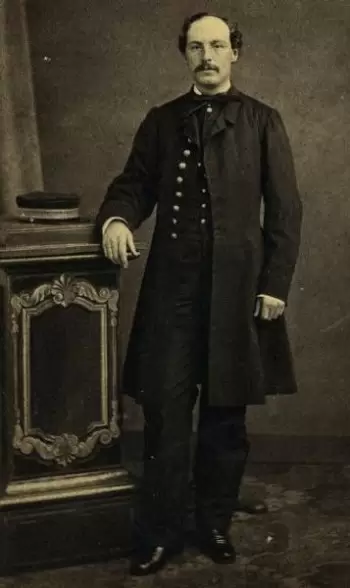
COX, WILLIAM H. (1841-1911). First lieutenant, 37th Regiment, New York State National Guard, Company B. Born in New York City, Cox had blue eyes and fair skin. He was a clerk at the time of the census of 1860. After enlisting at New York City as a sergeant on May 29, 1862, he mustered into the 37th Regiment that day, and mustered out after three months on September 2 at New York City. When his unit was reactivated on June 24, 1863, he was commissioned into the same company as a first lieutenant, and mustered out the next month on July 22 at New York City.
The censuses of 1870 and 1880 indicate that Cox was working as a bookkeeper. He may be the William Cox who is listed as a bookkeeper in the Brooklyn Directory for 1884-1886. In 1896, he applied for and received an invalid pension under certificate 930,322. He spent the last five months of his life at the Soldiers’ Home in Hampton, Virginia. He died from cardiac dilation. Interment at Green-Wood was on October 3, 1911. Section 161, lot 11263, grave 2.
COXSON, MARK STOPFORD (1845-1933). Private, 12th Regiment, New York State National Guard, Company I; 6th Independent Battery, New York Light Artillery. Coxson, who was born in New York City, first served as a private in the 12th Regiment for three months in 1862. He re-enlisted at New York City as a private on April 29, 1863, and mustered into the 6th Independent Battery, New York Light Artillery, that same day. On July 8, 1865, he mustered out with his battery at Hart’s Island, New York Harbor. The Veterans Schedule of 1890 confirms his military service.
Coxson is listed as a carpenter in the Brooklyn Directory for 1885-1886 and the New York City Directories for 1889-1890, 1892-1893 and 1895-1896. He was a merchant as per the census of 1900. He applied for and received an invalid pension in 1901, certificate 1,073,377. According to the census of 1910, he sold carpentry supplies; the censuses of 1920 and 1930 indicate that he was retired.
Remaining active in military affairs, he was a member of the James C. Rice Post #29 of the Grand Army of the Republic (G.A.R.) and served as commander of that post. At the 1930 Memorial Day Parade, he was photographed and identified as a Civil War veteran and adjutant, along with members of the Boy Scouts and the parade’s grand marshal, on Riverside Drive in Manhattan. At the time of his death, he lived at 270 East 162nd Street in Manhattan. His obituary in The New York Times, which confirms his Civil War service, indicates that he was survived by three sons and two daughters. Section 40, lot 4503.
COYLE, WILLIAM J. (1841-1918). Private, 79th New York Infantry, Company E. Coyle was born in Manhattan and was a stonecutter by trade. During the Civil War, he enlisted as a private on May 13, 1861, at New York City, mustered into the 79th New York, also known as the Scotch Highlanders, on May 28, and was sick and at Harewood Hospital in Washington, D.C., in September 1862. He was wounded at Fort Sanders in Knoxville, Tennessee, on March 24, 1864, and was discharged on May 31, 1864, at New York City. His obituary in the Brooklyn Standard Union, which confirms his Civil War service, notes that he was wounded in the right arm and was discharged for disability. He successfully applied for an invalid pension in June 1864, certificate 66,614.
His obituary indicates that Coyle was employed in the engine room on Governor’s Island, last serving in the Army Building there. A Brooklyn resident for 50 years, he was a member of the Rankin Post # 10 of the G.A.R. His obituary in the Brooklyn Daily Eagle also confirms his Civil War service. He last lived with his daughter at 521 Forest Avenue in Queens, New York. He died from myocarditis (heart disease). Section J, lot 33061.
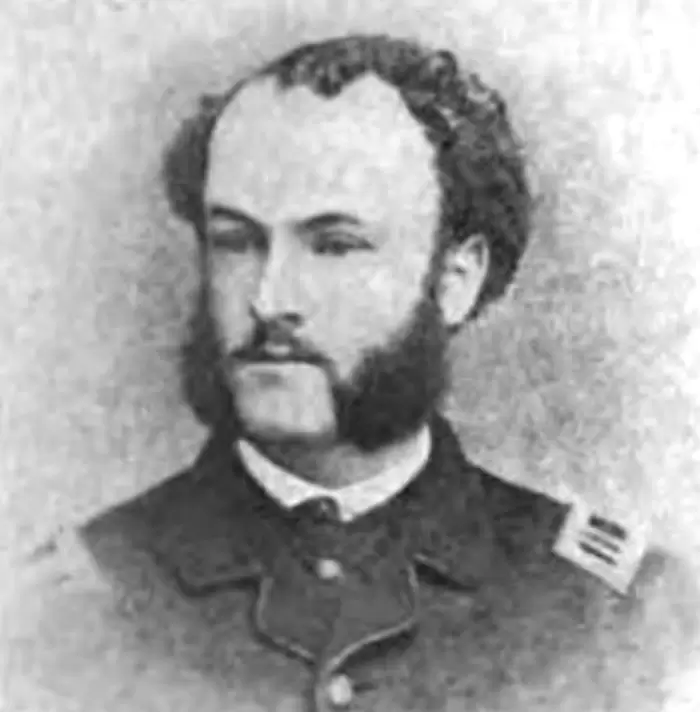
COYNE, JOHN NICHOLAS (1839-1907). Medal of Honor recipient; lieutenant colonel and major by brevet; captain, 70th New York Infantry, Companies B, F, and D; First Veteran Infantry; private, 7th Regiment, New York State Militia, Company G. Born in New York City, Coyne moved to Jersey City, New Jersey, after his father died in 1854. He was employed as an editor there in 1860. During the Civil War, he served with the 7th in 1861, enlisting for 30 days on April 19, 1861, mustering in seven days later, and mustering out on June 3. He then re-enlisted at New York City as a private on January 20, 1862, and mustered immediately into Company B of the 70th New York, known familiarly as the First Regiment of the Excelsior Brigade. He was promoted to sergeant on January 28, 1862, and demonstrated his gallantry on May 5, 1862, when he captured the enemy’s flag after a severe hand-to-hand contest in Williamsburg, Virginia, for which he was awarded a Medal of Honor on April 18, 1888. Historians allege that it was the first Confederate flag captured on the battlefield. An account of his action there read:
When the enemy were overtaken at Williamsburg the Third Excelsior, of the Seventieth New York Volunteers, was in advance. It was a dark, rainy morning. A heavy vapor covered the field, and the smoke of the battle obscured the scene. As the supporting regiment approached, the enemy, who were concealed in the thick woods, sent up the cry; “Show your colors!” The color-bearer waved the flag, and, as its folds spread out and showed the stars and stripes, the rebels advanced from the woods and opened fire. The fire was returned so effectively that they were driven back. Another advance, with re-enforcements, was also repulsed by the valiant Excelsiors.
After several hours of conflict the ammunition became exhausted, and the New Yorkers were ordered to fall back by companies. Sergeant Coyne’s company, which during the latter part of the battle was under his command, the captain and lieutenant having been disabled, became separated, and a number of them, missing their way, found themselves with their leader confronted by a party of the enemy surrounding their color-bearer.
“Let’s capture their colors, boys!” shouted Coyne, and, with a ringing cheer, the little band made a dash for the enemy. Coyne singled out the color-bearer and rushed upon him. The rebel was too strong to be conquered by such an assault, and defended his flag bravely until a bullet, shattering his right hand forced him to loosen his hold and enabled Coyne to drag the trophy from him. Tearing the flag from the staff and tying it around his body, he turned to offer battle to any one who should attempt to retake it but the survivors of the enemy were hurriedly leaving the field before a rescuing party sent by General Heintzelman. Of the brave band who had supported their leader but a few remaining standing, and Sergeant Cook, Corporal Beekman, and Privates Howard and Lynch were killed outright.
Subsequently, he was noted for bravery by General Heintzelman. He was promoted to second lieutenant on May 7, 1862, effective upon his transfer to Company F, and was cited by Colonel Dwight for “gallant and conspicuous conduct.” Later that year, he was wounded in the arm at Fair Oaks, Virginia, on July 1, the same day he was captured at Savage Station, and exchanged the next month on August 27. He was commended by Hooker for gallantry at Bristoe Station, Virginia, and was slightly wounded at Second Bull Run, Virginia. He became a first lieutenant on December 27, 1862, and fought in Virginia at Fredericksburg and Chancellorsville. At the Battle of Gettysburg, Pennsylvania, on July 2, 1863, he was wounded in the scalp, and was promoted to adjutant. His actions there were singled out, “Adjutant J. N. Coyne, First Regiment Excelsior Brigade, particularly distinguished himself for coolness and bravery during the most trying moments, and fully sustained the high character won in previous actions.” Subsequently, during action at Wapping Heights, Virginia, his horse was shot under him. He was promoted to captain on July 24, effective upon his transfer to Company D and took part in the Virginia actions at Cold Harbor and Petersburg. After he mustered out in July 1864, he was appointed captain in Hancock’s First Veteran Infantry, and resigned June 12, 1865. He later received brevets to major and lieutenant colonel, New York Volunteers.
After the Civil War, Coyne became a custom house clerk in Jersey City, and became active in the Mutual Aid Society of the Jersey City and Bergen Railroad Company in the 1880s and 1890s. He and his wife, Sally Matthews Coyne, had two daughters. His wife died in 1883. He is listed as a clerk at the Custom House in the New York City Directory for 1889-1890; during those years, he lived on Hampton Court in Jersey City. By 1890, he had risen to chief clerk of the disbursing department at the New York Custom House. He authored the History of the Third Army Corps and a History of the Excelsior Brigade.
His obituary in the New York Herald included notices of his death from the Military Order of the Loyal Legion, a patriotic organization of Union officers, and the Society of War Veterans of the 7th Regiment, of which he had been a past president; members of both organizations were requested to attend his funeral. Philadelphia newspapers were asked to print a notice of his death. (His older daughter was born in Pennsylvania in 1863.) His last residence was at 157 North Walnut Street in East Orange, New Jersey. His death was caused by pleurisy. Section 82, lot 5631.
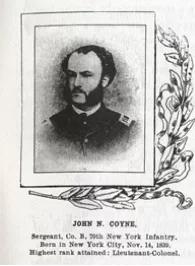

COZINE, CHARLES (1837-1884). Private, 21st Regiment, New York State National Guard, Company A. He may be the Charles Cozine listed as a blockmaker in the Brooklyn Directory for 1857-1862. After Cozine enlisted in 1863, he mustered into Company A of the 21st New York State National Guard and served for its 30-day activation. It is possible that he is the Charles Cozine listed as an ice-dealer at 378 Warren Street in the Brooklyn Directory for 1880-1882. His last residence was 136 Douglass Street in Brooklyn. The cause of his death was an accidental fall. Section 14, lot 4969, grave 61.
CRABBE, EDWARD LUIS (1825-1882). Engineer. Born in Cuba, he came to the United States as a youth. Crabb was 5′ 7″ tall and had blue eyes. Trained in mechanical engineering, he established a sugar refinery, Crabb and Wilson Sugar Refiners, which did business with his native country where his family owned sugar plantations. He and the aforementioned firm are listed as sugar refiners in the Brooklyn Directory for 1857. During the Civil War, he entered government service and was placed at the head of the drafting office in New York. He was engaged in preparing plans for the ironclad battleship, the Monitor, and other engineering projects.
Toward the end of the war, Crabb began the manufacture of sugar from molasses at the Brooklyn Sugar-house located on Bridge Street. He became a naturalized U.S. citizen on November 11, 1865. As per the Brooklyn Directories for 1865 , 1868, and 1870-1873, he was in the sugar business and lived on Schermerhorn Street. The Brooklyn Directory for 1873-1876 indicates that he was in sugars and lived in Great Neck, Long Island. Remaining in business throughout his lifetime, he died at his home in Great Neck. His death was attributed to heart disease. As per his obituary in The New York Times, which confirms his Civil War government service, his funeral took place at St. Ann’s Protestant Episcopal Church. He was survived by his widow and six children. Section 149, lot 16681.

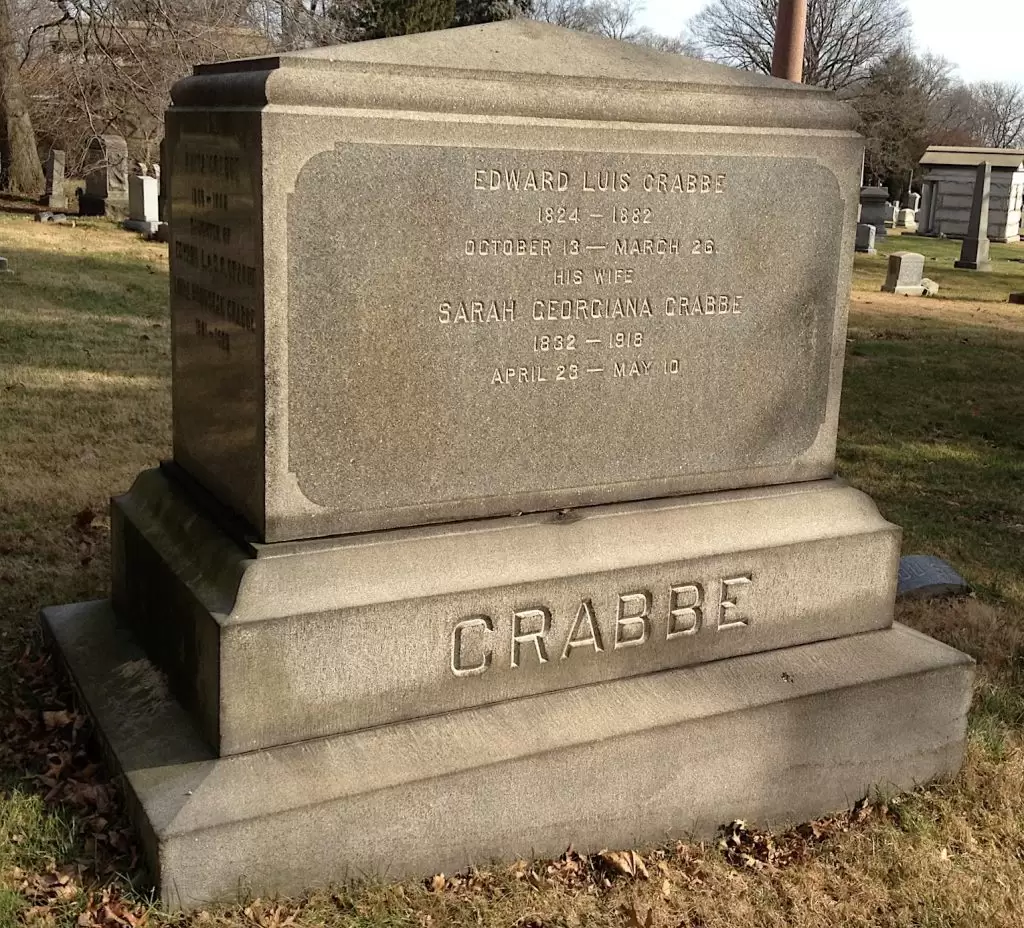
CRABTREE, JAMES H. (1844-1918). Second lieutenant, 155th New York Infantry. Crabtree was born in Vernon, New Jersey. After enlisting at New York City as a second lieutenant on October 10, 1862, he was commissioned into the 155th New York, but not assigned to any company. According to the census of 1870 and the Brooklyn Directory for 1873-1876, he was a bookkeeper; in 1880, he was working as a store clerk. As per the Brooklyn Directories for 1888-1890 and 1890-1892, he was employed as a bookkeeper.
On January 23, 1896, an article in the Brooklyn Daily Eagle reported that Crabtree and his horse collided with another horse and buggy on Ocean Avenue in Brooklyn, throwing Crabtree into the street where he wounded his scalp and fractured his leg; the runaway horse was caught by a mounted policeman. In 1900, the census shows that he was a bookkeeper for building supplies; in 1910, he was a bookkeeper in a bank. His obituary in the Brooklyn Daily Eagle states that he was employed as the manager of a brick plant in Brooklyn where he lived for more than 60 years. The Brooklyn Daily Eagle also noted that he was a distant relative of Lotta Crabtree, a well-known entertainer, actress and philanthropist. His funeral took place at the home of his daughter at 2401 Avenue M in Brooklyn. His death was attributed to apoplexy. Section 204, lot 30374.
CRAFT, JOHNES (or JOHN F.) (1841–1901). Private, 155th New York Infantry, Company B. On October 3, 1862, Craft, a native of New York, enlisted and mustered into the 155th New York at New York City, and deserted there three days later. His last residence was 57 Ocean Avenue in Brooklyn. Section 69, lot 3759.
CRAIG, GEORGE E. (1846-1874). Private, 13th Regiment, New York State National Guard, Company F. Craig enlisted at Brooklyn as a private on May 26, 1862, and immediately mustered into the 13th. He mustered out at Brooklyn on September 12, 1862. When the 13th was reactivated in 1863, he served for 30 days. His last residence was 1080 Pacific Street, Brooklyn. Craig died from phthisis. Section 186, lot 19928.
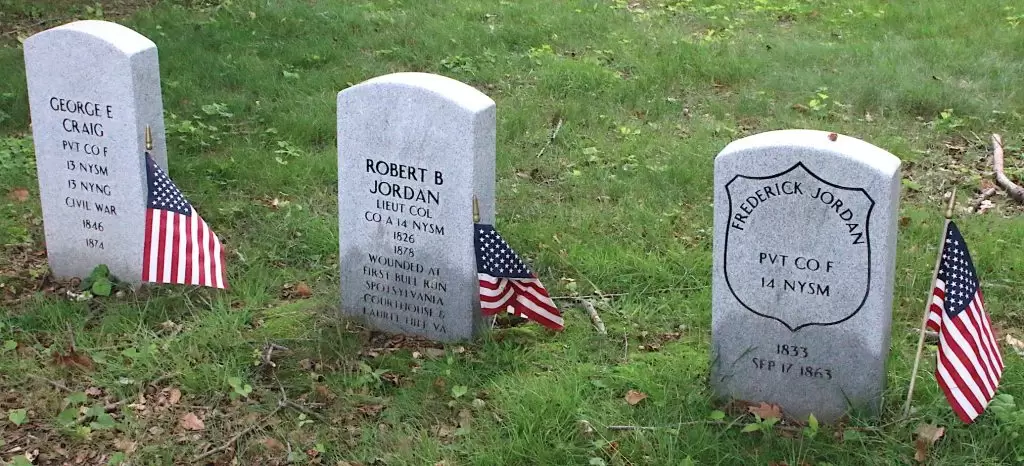
CRAM (or CRUM), CHARLES (1838-1861). Private, 53rd New York Infantry, Company B. Born in New York State, Cram enlisted as a private at New York City on September 5, 1861, the same day that he mustered into Company B of the 53rd New York. He died of heart disease a short time later, on December 26, 1861, at Annapolis, Maryland. He was buried at Green-Wood on February 17, 1862. Section B, lot 8575, grave 44.
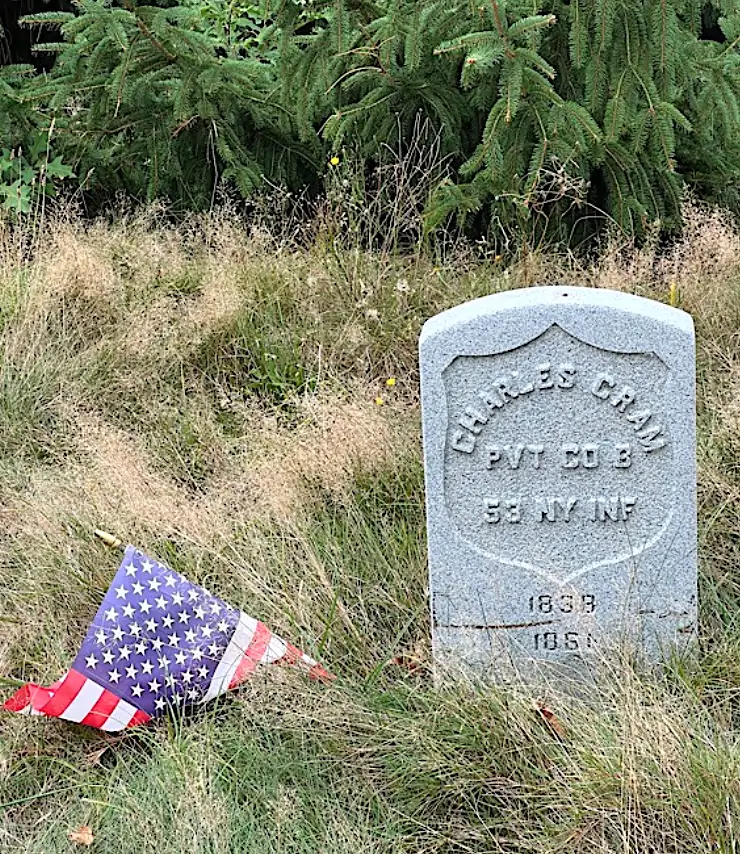
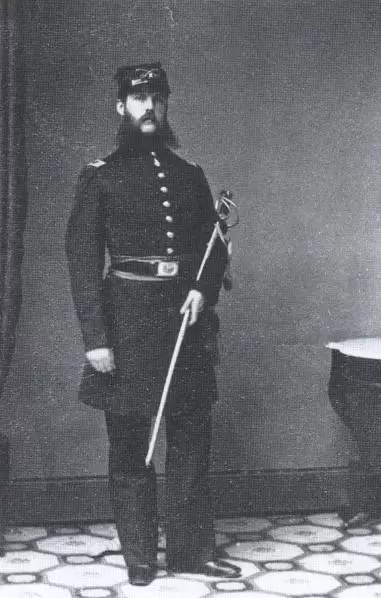
CRAM, GEORGE CLARENCE (1830-1869). Major by brevet; colonel, 22nd New York Cavalry, captain, 3rd and 6th United States Cavalry. After enlisting as a captain in the 3rd United States Cavalry on May 14, 1861, Cram, a native of New York, was assigned to the 6th Cavalry on August 3 of that year. He commanded the 6th as a senior officer in late 1862 and in 1863, when the 6th was reorganized into a brigade in the Army of the Potomac, continued his leadership role. On June 9, 1863, he was brevetted major for “gallant and meritorious service at the Battle of Beverly Ford, Virginia.”
On June 23, 1863, Cram described an unsuccessful charge two days earlier at Upperville, Virginia, “…The men were exhausted and worn out by the recent imposition of incessant picket duty in their position near Middleburg. They were taken from behind stone walls which they had been guarding all night and the day before, mounted on horses as famished as themselves, and immediately marched with the column, and at the end of a fatiguing day were required to charge over ground almost impracticable in its nature and 750 paces in extent, as proved by the measurement of experienced officers on the morning of the 22d…” He was promoted to colonel of the 22nd New York in 1864, but did not join the regiment because Colonel Samuel Crooks, who had been dishonorably discharged, was restored to his command. Cram then served as provost marshal in New York, traveling on inspection tours through the north. In October 1867, he was commissioned a major in the 4th Cavalry and continued with that unit until he resigned from the service in January 1869. He last resided in Stamford, Connecticut. His death was caused by gout. Section 74, lot 18997.
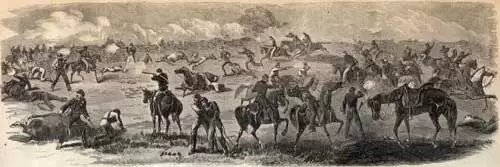
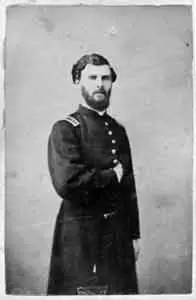
CRANE, CYRUS R. (1836-1888). Captain, 5th Vermont Infantry, Companies C and K; deputy provost marshal, United States Volunteers; third corporal, 71st Regiment, New York State Militia, Company C. Born in Bridgeport, Vermont, and a resident there, Crane enlisted and served in the 71st Regiment for 30 days in 1861, mustering into Company C as a corporal, and mustering out with the rank of third corporal. On September 4, 1861, he enlisted in the 5th Vermont, was commissioned into Company F the same day as a first lieutenant, and was promoted to captain on June 21, 1862. On January 24, 1863, he was transferred to Company K and was discharged for wounds (received on an unstated date) on March 13, 1863. Pension records show that he also saw service as a deputy provost marshal in the U.S. Volunteers. On March 24, 1863, his application for an invalid pension was granted under certificate 10,564.
At the time he applied for a passport in 1865, he was 5′ 8″ tall with gray eyes, a prominent nose, brown hair and fair complexion. His first wife, Juline Pond Crane, died in 1867. After the War, Crane lived in Massachusetts, and was a member of the G.A.R. Post #158 there. According to the census of 1880, he was employed as a manufacturer of bedspreads in Barrington, Massachusetts, in the Berkshires. The January 5, 1889, edition of Scientific American notes that Crane had a patent for a washing machine used in bleaching fabrics. The history of the Housatonic Water Works shows that Cyrus Crane was a customer who purchased a contract to buy $750 worth of water from the mill for several years. Crane’s military service is confirmed by Veterans Schedule of 1890 which indicates that he disabled his knee after he fell from a horse. He died in Housatonic, Massachusetts. The cause of his death was pneumonia. Marie Leonore Crane, who is interred with him, applied for a widow’s pension in 1895, application 624,460, but there is no certificate number. Section 145, lot 26799.
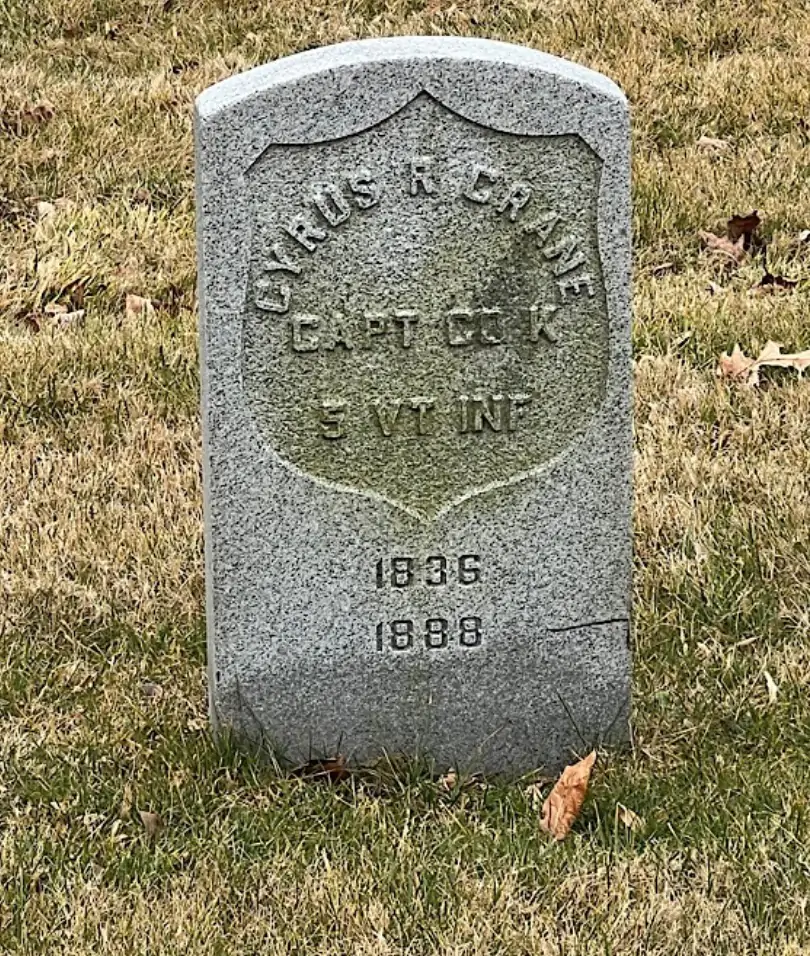
CRANE, GEORGE L. (1835-1912). Sergeant, 133rd New York Infantry, Company B. Crane, who was born in New York, was a railroad conductor whose personal worth was $300 as stated in the census of 1860. After enlisting as a corporal at Brooklyn on August 21, 1862, he mustered into the 133rd New York on September 24. According to the muster roll, he was 5′ 7″ tall with hazel eyes, dark hair and a light complexion. During his military service, he was promoted to sergeant, then commissioned second lieutenant on April 23, 1864, but did not muster in at that rank. He was reduced to ranks as a private on August 11, 1864, and mustered out on June 6, 1865, at Washington, D.C.
In 1870, the census states that Crane was a butcher; the 1880 census indicates that he worked for the Fire Department. In 1890, he applied for and was granted an invalid pension under certificate 773,873. His family resided in Richmond Hills, Queens, but he died at the Soldiers’ Home in Kearny, New Jersey, having been a resident of Ridgefield Park where he belonged to Post# 110 of the G.A.R. According to his obituary in the Brooklyn Daily Eagle, he was last employed as a weigher. He died from nephritis. Susan Crane, who is interred with him, applied for and received a widow’s pension, certificate 740,509. Section 174, lot 17456.
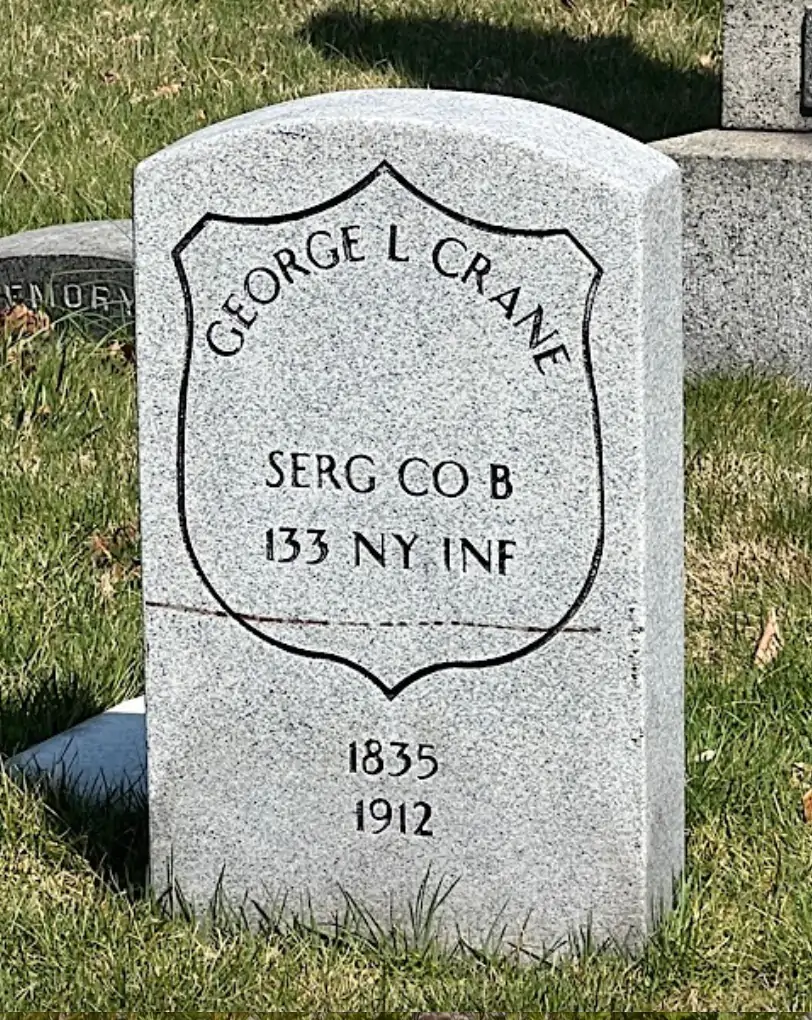
CRANFORD (or CRAWFORD), EBENEZER (1830-1872). Private, 83rd New York Infantry, Company L. A native of Newfoundland, Canada, he enlisted at New York City as a private on September 2, 1861, the same day that he mustered into Company L of the 83rd New York. He was discharged on May 26, 1862, at Washington, D.C, for disability. According to the census of 1870, he was employed as a clerk. He was the brother of Henry Loud Cranford (see). His last residence was 62 East 12th Street in Manhattan. His death was attributed to a dose of Paris green, a poison. Section 90, lot 3802.
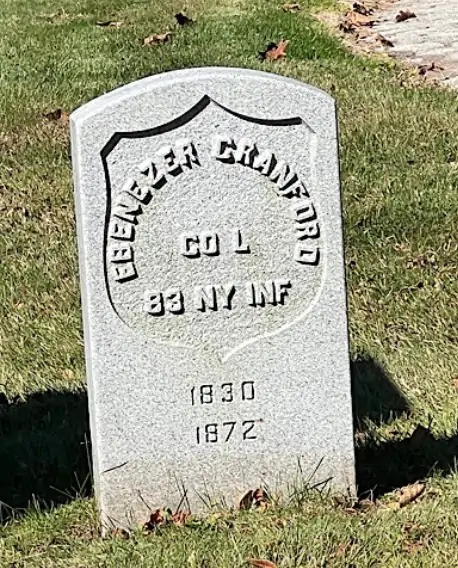
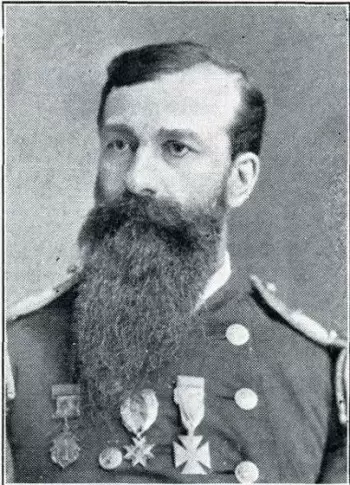
CRANFORD (or CRAWFORD), HENRY LOUD (1833-1896). Major by brevet; captain and commissary of subsistence, United States Volunteers Commissary Department; first lieutenant and quartermaster, 84th New York (14th Brooklyn) Infantry, Company G. Born in Newfoundland (although the soldier record and census incorrectly lists New York as his birthplace), Cranford enlisted at Brooklyn as a quartermaster sergeant on April 18, 1861. He was promoted to first lieutenant and mustered into the 14th on May 23, but was not commissioned. He rose to the rank of first lieutenant and quartermaster on February 20, 1862, without being commissioned.
Colonel Walter Phelps Jr. of the 22nd New York and the commanding officer at the Battle of South Mountain, Maryland, on September 14, 1862, wrote from Sharpsburg, Maryland, on September 20 citing Cranford (and another officer) for actions on the field there (when Cranford could have avoided combat since he was the regimental quartermaster), “…I was often obliged to send them, through a galling fire, to different parts of the field with orders. Their conduct on this occasion was most gallant, and all that I could have desired.” He was discharged for promotion on March 23, 1863, at Pratt’s Landing, Virginia. On that date, he was commissioned into the United States Volunteers Commissary Department as captain and commissary of subsistence and borne on the rolls as “Crawford.” According to his obituary in the Brooklyn Daily Eagle, he was assigned to the staff of General Wesley Merritt as chief commissary of the First Cavalry division of the Army of the Shenandoah, under General Phil Sheridan. He participated in all the engagements of this army, including the memorable fight at Winchester, Virginia, was wounded three times, and was present at the Confederate surrender at Appomattox Court House. Cranford was brevetted major on July 5, 1865, “for efficient and meritorious service” and mustered out the next day.
As per the 1870 census, he was living in Brooklyn where he was the manager of the Scrimshaw Paving Company. The Brooklyn Directory for 1873-1876 lists him as a contractor at 16 Court Street; he lived during those years at 633 Pacific Street. In 1878, he was living in Washington, D.C., where he was a paving contractor. At the time he applied for a passport in 1880, he was 5′ 7″ tall with a prominent nose, dark grey hair, moustache and beard, hazel eyes and a florid complexion. The 1880 census confirms his occupation as a contractor. A Freemason in New York, he was active in many fraternal groups in Washington, D.C., including the Military Order of the Loyal Legion, a patriotic organization of Union officers, the Society of the Army of the Potomac, and was governor of the Army and Navy Club. He was the brother of Ebenezer Cranford (see). His last residence was in the suburbs of Washington, D.C., where he lived at 1634 Park Street in Mount Pleasant. His death was attributed to cirrhosis. He was survived by his widow, Margaret Jane Munn Crawford, who is interred with him, and two adult children; three children predeceased him, two as young adults and one as a youngster. Section 90, lot 3802.
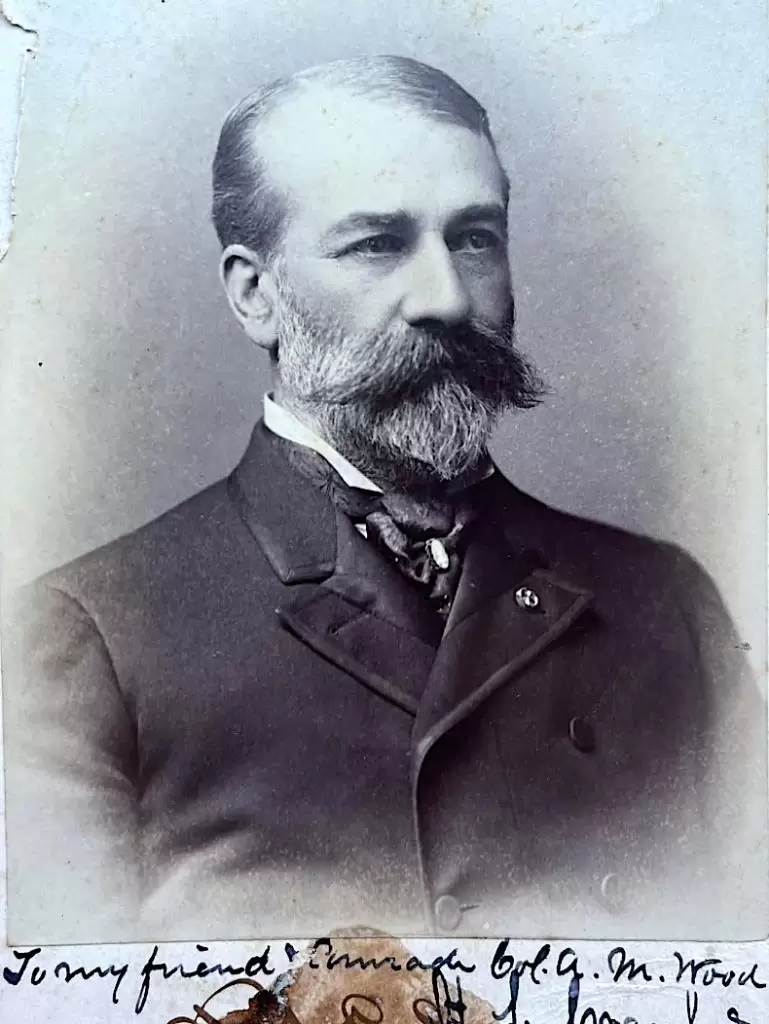
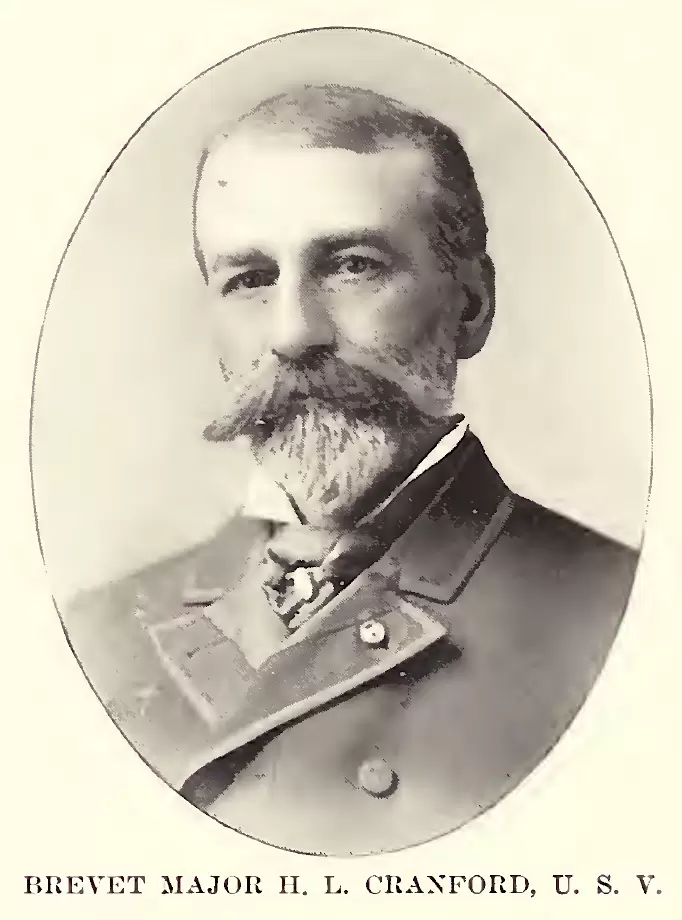
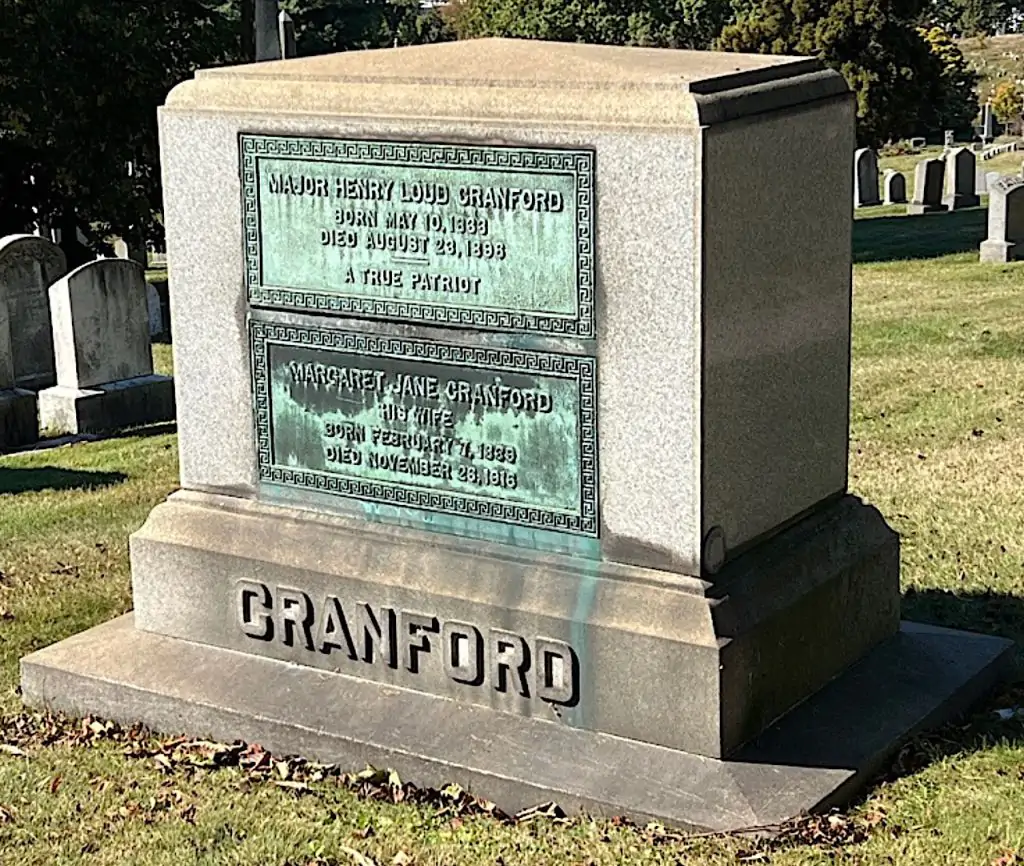
CRANKSHAW, JONATHAN S. (1827-1896). Private, 7th Regiment, New York State National Guard. Originally from England, Crankshaw became a naturalized citizen on August 29, 1849. According to the Brooklyn Veterans Schedule for 1890, he enlisted as a private at Brooklyn on October 28, 1862, and served with the 7th National Guard for eight months.
The New York City Directories for 1875-1876, and 1877, and the Brooklyn Directory for 1880-1882 report that he was employed in the dry goods business at 47 Catherine Street in Manhattan; the latter directory indicates that he lived at that time at 190 Kosciusko Street. The 1890-1892 Brooklyn Directory lists him as a clerk. His last residence was 319 Lewis Avenue in Brooklyn. Crankshaw died from emphysema. Section 15, lot 7750, grave 3.
CRANSTON, HIRAM AUGUSTUS (1840-1861). Pinkerton detective. A Long Island native, Cranston was living in Hempstead with his family as per the 1850 census. In 1857, he was a sophomore at the University of the City of New York and was living at the New-York Hotel. He appears to have been an agent of the Pinkerton National Detective Agency, formed in 1850 by Allan Pinkerton, which provided personal security as well as military intelligence and scouting for the Union during the Civil War. Pinkerton, dubbed “America’s first private eye,” served as Major General George McClellan’s chief of intelligence during the Civil War, and provided security for President Abraham Lincoln.
Cranston was listed as a body in transit, a list that recorded Civil War deaths and their destinations for burial. However, his obituary in The New York Times indicates that he died from typhoid fever in Stephentown, Rensselaer County, New York. His last address was 721 Broadway in Manhattan. His funeral took place at the New-York Hotel. The following poem was inserted in his obituary:
Grieve for the living, not the dead;
An early fate from life hath sped.
Whom angels all its toils have sparked,
But not the hearts his loss hath heard.
Section 153, lot 21950.
CRANSTON (or CRANTSEN), JOHN (1831-1863). Corporal, 82nd New York Infantry, Company A. Of Irish birth and a resident of 574 Second Avenue in Manhattan, Cranston enlisted as a corporal at New York City on May 21, 1861, and mustered that day into the 82nd New York. After being mortally wounded at Gettysburg, Pennsylvania, on July 2, 1863, he succumbed on July 27 at West’s Buildings Hospital in Baltimore, Maryland. Section 115, lot 4196, grave 355.
CRAVEN, AUGUSTUS CARTER (1840-1863). Second lieutenant, 4th Light Artillery, Regular United States Army. As per his online family tree on the Ancestry.com website, Augustus was born in Brooklyn to Tunis Augustus Macdonough Craven and Mary née Carter. His father and grandfather were Navy officers; his mother was the daughter of a prominent family, who died when Augustus was three years old, leaving three young children. At the times of the 1850 and 1860 censuses, Augustus was living in Somerset County, New Jersey. The 1850 census reports that Augustus was living with T. Augustus and Maria Louis Craven (née Stevenson), his father’s second wife, an older sibling, Mary Augusta, and younger brother, Robert. Also in the household were numerous adults and children, relationships unknown. Augustus’s father and his second wife had three of their own children. The 1860 census, which recorded the family name as Cravere, shows Augustus living in Bound Brook, New Jersey with T. Augustus and Maria L. along with his two siblings and three young step-siblings, and Thomas and Ann Gerety, relationship unknown.
As per his soldier record, Augustus enlisted in the United States Army as a second lieutenant on October 24, 1861, and was commissioned that same day into the 4th Light Artillery. On March 19, 1863, he died of disease in Bound Brook, and was buried four days later. The records of the Episcopal Diocese of New Jersey, incorrectly names him as an officer in the Navy; that error is likely confusing Augustus with his father, a career Naval officer. His obituary in The New York Times reports that he was the eldest son of T. Augustus Craven, United States Navy, and that his death was attributed to typhoid fever that he apparently had contracted while in service. Sadly, his father, the commander of the USS Tecumseh, died on August 5, 1864, at the Battle of Mobile Bay, when his ship struck a mine and sank; there were few survivors.
On January 23, 1923, an obituary for Mary Craven Thomae, the New Jersey historian of the Daughters of the American Revolution, appeared in the Courier-News of Bound Brook. Mary was mentioned as the daughter of Commander Tunis A. M. Craven, and given her age of 84, was Augustus’s sister. As per Find A Grave, Augustus’s grave is unmarked. Section 42, lot 2380.
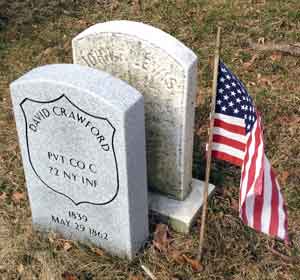
CRAWFORD, DAVID (1839-1862). Private, 72nd New York Infantry, Company C. After enlisting and mustering into the 72nd as a private at New York City on December 4, 1861, Crawford, a native of New York who lived on Portland Avenue in Brooklyn, was wounded in battle on May 5, 1862, at Williamsburg, Virginia, and succumbed to those injuries at Baltimore, Maryland, on May 29. He was interred at Green-Wood on August 3 of that year. Section 115, lot 13536 (Soldiers’ Lot), grave 58.
CREAMER, JOSEPH N. (or M.) (1842-1917). Private, 12th Regiment, New York State Militia, Company E; 1st New Jersey Cavalry, Company M. Born in New York City, Creamer was educated at the Ludlow Street public school and then studied architecture and pattern-making. As per his biographical sketch in History of Long Island, he first enlisted in Company E of the 12th Regiment in April 1861 and served under Colonel Daniel Butterfield. During Creamer’s three month enlistment, the 12th served at or near Washington, D.C., and then with the Army’s department of Pennsylvania. That biography reports that he re-enlisted soon after his discharge, as did many of his comrades, and mustered into the 1st New Jersey Cavalry; that unit was assigned to the Army of the Potomac for patrol, flank and other special duties. Creamer’s soldier record notes that he enlisted as a private on August 28, 1863, and mustered into the 1st New Jersey Cavalry three days later. He mustered out on July 24, 1865. Creamer’s pension index card confirms that his service in Company E of the 12th New York State National Guard.
He may be the Joseph N. Creamer who is listed as a moulder in the Brooklyn Directories for 1868 and 1890-1892. In 1876, Creamer mustered into Rankin Post #10 of the G.A.R., then joined Barbara Frietchie Post #11. In the latter post, he served as senior vice-commander, three terms as adjutant and two terms as commander. In addition, he was a delegate to the G.A.R.’s memorial convention eight times, a delegate to the State encampment for four years, and, in 1898, was appointed as aide on the staff of the department commander, and was commander-in-chief on the staff of Oliver D. Shaw, grand commander. Remaining active in military affairs, his biographical sketch indicates that he had been a member of the 7th Regiment and the 47th Regiment of Brooklyn. Creamer was also a member of the Brooklyn Masonic Veterans. In 1904, his application for a pension was approved, certificate 1,102,788.
As per his obituary in The New York Times, which confirms his Civil War service, he was employed for many years in the pattern department of the Brooklyn Navy Yard. His obituary in the Brooklyn Standard Union, which also confirms his Civil War service, indicates that he was a retired mechanic at the Navy Yard. He last lived in Newark, New Jersey. His funeral was held at the home of his nephew on 281 Winthrop Street in Brooklyn. He was survived by one daughter. Section 137, lot 31341.
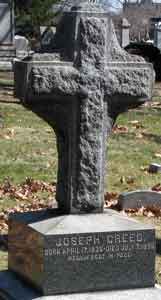
CREED, JOSEPH (1836-1895). Private, 4th Regiment, United States Army, Company G. Originally from Tipperary, Ireland, Creed immigrated to the United States in 1852. On August 14, 1854, he enlisted at New York City and began service in the 4th Regiment, United States Army (Artillery), Company G. A resident of Fort Randall, Nebraska, according to the census of 1860, he had a personal worth of $50. A carpenter at the time of his enrollment, he stood 5’7″ tall with hazel eyes, brown hair and a fair complexion. During the Civil War, he served with Company G from April 1861 through February 1864. His pension record indicates that he also served in the 42nd U.S. Infantry, Company F.
Creed continued in the military and was a clerk with the United States General Service after the War. In 1870, the census shows that he was a clerk in a government office and is listed as a clerk in the New York City Directory for 1876-1878. He was discharged on June 20, 1885, at Governor’s Island, New York. As per the Brooklyn Directories for 1888-1890 and 1890-1892, he was working as a clerk. The Veterans Schedule of 1890 confirms his military service during the Civil War. In 1894, Creed successfully applied for an invalid pension, certificate 877,547. At the time of his death, he resided at 314 East 15th Street in Manhattan. His death was attributed to Bright’s disease. His widow, Rose Creed, received a pension in 1895, certificate 431,447. Section 192, lot 27505, grave 1.
CREGAN, CHRISTOPHER (enlisted as CAINE, CHARLES) (1848-1901). Private, 1st Maine Sharpshooters, Company E; 20th Maine Infantry, Company E. Born in New York and a resident of Wiscasset, Maine, Cregan enlisted as a private on an unknown date using the alias “Charles Caine.” He mustered into the 1st Maine Sharpshooters on November 28, 1864, and transferred into the 20th Maine on June 21, 1865, from which he mustered out on July 16, 1865. Although his death certificate lists his birth year as 1853, a descendant, Joseph T. McMahon III, possesses other documents that suggest a birth year of about 1848. His pension record, indicating the alias of Charles Caine, notes that he applied for and was granted an invalid pension in 1892, certificate 886,748.
In civilian life, he was a machinist when he married in 1881 and at the time of his death, he was employed as a steam fitter. He last lived at 306 East 43rd Street in Manhattan. Shortly after his death in 1901, his wife was awarded a widow’s pension, certificate 515,824. On a contract dated March 8, 1901, the Vermont Marble Company of Proctor, Vermont, was hired to make a gravestone for him. Section 117, lot 10975, grave 1158.
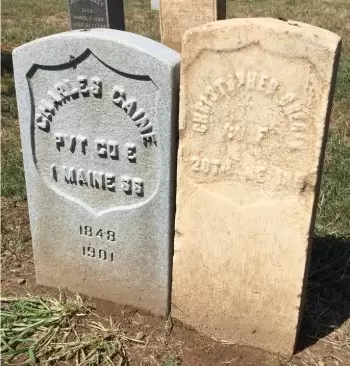
CREGIER (or CREIGER), JOHN A. (1815-1888). Lieutenant colonel, 11th New York Infantry. A native New Yorker, Cregier became a volunteer fireman at age 20 with Engine Co. #9 on Beaver Street in Manhattan, then joined Engine Co. #12 on William Street in 1840. Subsequently, he organized Engine Co. #40, became an assistant engineer in 1847, and retired in 1860. He was an executive of the Mercantile Insurance Company.
During the Civil War, Cregier enlisted at age 46 at New York City on April 20, 1861, and was commissioned into the Field and Staff of the 11th New York—the Fire Zouaves–as major on May 7. According to the muster roll, he was paid $99.10 by New York State for that period. He was promoted to lieutenant colonel on June 7. Cregier fought at the Battle of First Bull Run, Virginia, on July 21, 1861, where his regiment was routed on Henry Hill and came under much criticism. Colonel J. H. Hobart Ward, the commanding officer, praised Cregier in his field report from Shooter’s Hill, Virginia, on July 29, 1861, for ceaselessly “rallying and encouraging his men.” Captain Michael C. Murphy wrote of Cregier at the Battle of First Bull Run, “Old Cregier rode along the lines as coolly and collected as when walking up Broadway smoking a Havana…one of my men was cut in two by a rifled cannon ball, throwing the upper part of his body against Cregier’s horse, covering saddle and all with blood and intestines of the poor lad.” On August 4, 1861, the New York Herald listed Cregier, lieutenant colonel of the Fire Zouaves, as among the wounded at the Battle of Bull Run, “carefully corrected from the most authentic sources.”
Private Arthur O’Neil Alcock, whose features on the 11th New York were published in the New York Atlas and Leader, wrote of Cregier, “Lieut. Col. Cregier figures largely as the officer of the day. When mounted on his gallant steed he visits the outposts, there are few indeed along the roads for miles around the camp, who cannot now recognize his erect figure and martial bearing, as he comes dashing down the road, armed cap-a-pie. Unremitting in attention to his duties, affable and courteous in his intercourse with his men, gallant and polite to strangers, the Lieutenant Colonel has made fast friends of many who have in old times worked hard against him, and to sum up all, he is a great favorite of the laddies.” Cregier resigned on September 21 of the same year.
The 1880 census states that he was living on Morton Street and was retired. As per his obituary in the New York Herald, Cregier was a Freemason and a member of the Palestine Commandery of the Knights Templar. He last lived at 53 Morton Street in Manhattan. His funeral included Masonic and firemen’s honors. Section C, lot 20464.

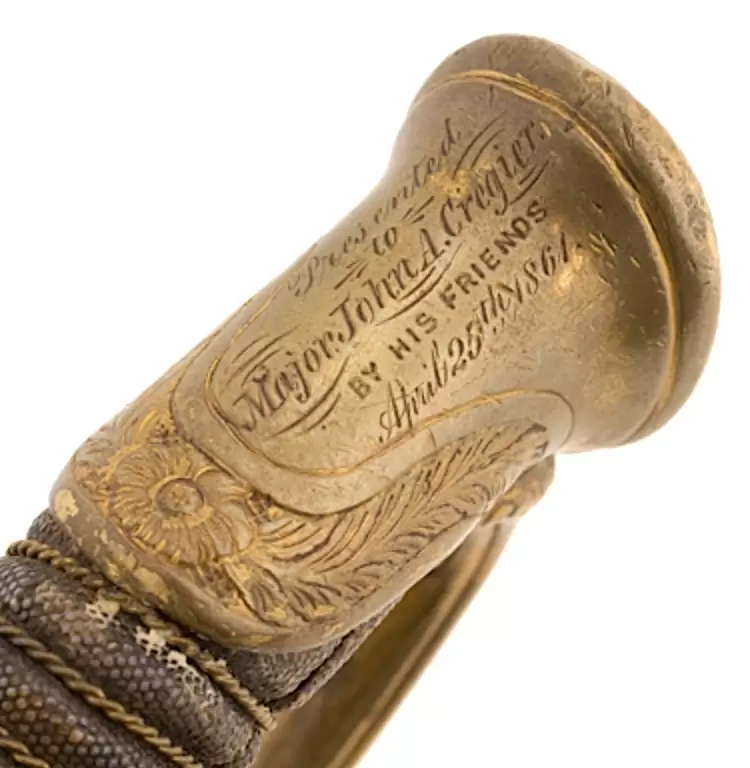
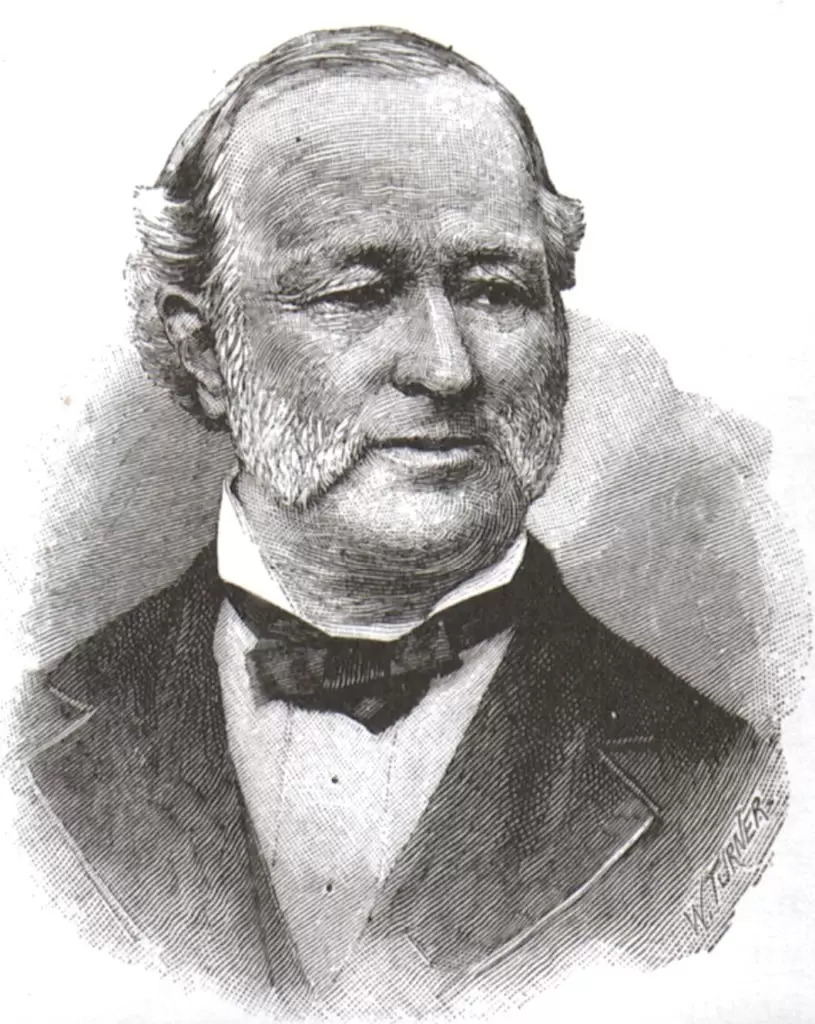
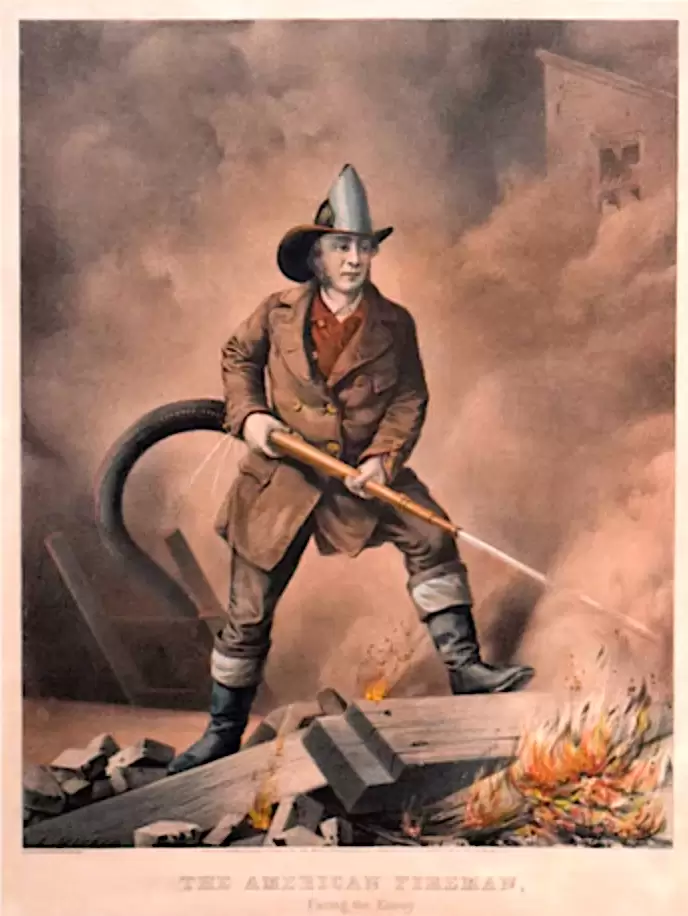
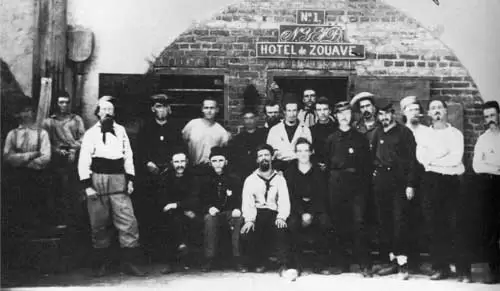
CREIGHTON, FREDERICK (1836-1897). Second lieutenant, 170th New York Infantry, Company E; sergeant, 5th New York Infantry, Company B. Creighton, a clerk at the start of the War, was 5′ 11¾” with brown eyes and dark complexion and hair. He enlisted on April 20, 1861, and mustered into the 5th New York as a sergeant on May 9. When he failed to obtain a commission in the “Oregon Rifles” in October 1861, he informed his captain on February 2, 1862, that he was stepping down as a non-commissioned officer because he felt qualified for that higher position. He was reduced to ranks on February 17, 1862. A month later on March 12, he was detailed to escort the body of Colonel Joseph DeMonteil (see) to New York City. Wounded in the right buttock, thigh and left testicle and taken prisoner at Second Bull Run, Virginia, on August 30, 1862, he was paroled two days later at Centreville, Virginia, and treated at Fairfax Seminary Hospital and at the Patent Office Building in Washington, D.C. He was discharged for promotion at New York City on October 16, 1862, transferred into the 170th and was commissioned that date as a second lieutenant. He was discharged from the 170th on March 31, 1863, on account of health, the surgeon’s certificate citing “deafness, debilitated and broken down from the privations endured while in the service.” When the 5th Regiment returned to New York in May 1863, he served on the welcoming committee.
After the war, he worked as a real estate assessor for Kings County and as a newspaper reporter. Creighton is listed as a journalist who lived at 308 Henry Street in the Brooklyn Directory for 1873-1876. He applied for and received an invalid pension in 1879, certificate 174,004. He may be the Frederick Creighton who is listed as a bookkeeper in the Brooklyn Directory for 1880-1882 and as a clerk at the Hall of Records in the Brooklyn Directory for 1890-1892. His last residence was at 913 Schermerhorn Street, Brooklyn. As per his obituary in the New York Herald, his funeral took place at the undertaking establishment of Mr. Genung at 368 Fulton Street in Brooklyn. In 1897, his widow, Elizabeth L. Creighton, applied for and received a pension under certificate 715,254. Section 114, lot 21559.
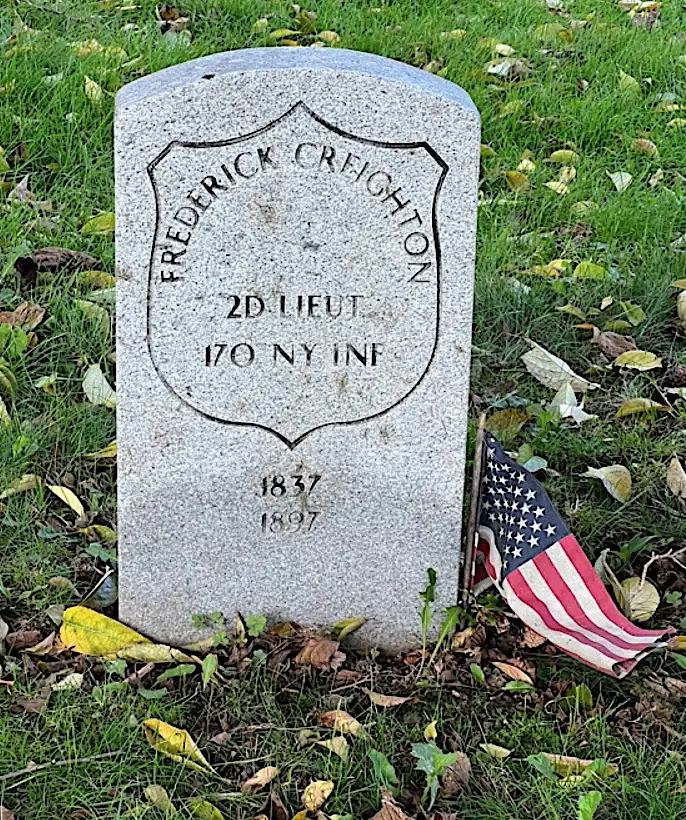
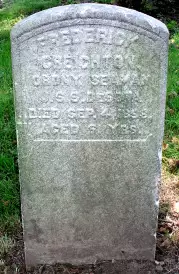
CREIGHTON (or GILLENCK, GILLENK), FREDERICK (1847-1898). First class boy, United States Navy. A native of New York City, whose father died when he was an infant, he used his step-father’s surname when he enlisted in the United States Navy on January 2, 1864, as Frederick Gillenck. A printer, he was 5′ 3″ tall with hazel eyes, brown hair and a fair complexion that was pock-marked. He served as a first class boy aboard the following ships: USS North Carolina (January 2, 1864-September 8, 1864); USS Vanderbilt (September 8, 1864-March 25, 1865); USS North Carolina (March 25, 1865-May 9, 1865); USS Taloma (May 9, 1865-July 24, 1865); USS Ohio (July 24, 1865-November 10, 1865); USS Vermont (November 10, 1865-March 12, 1866); and the USS DeSoto (March 12, 1866-April 25, 1867). He was discharged at Hampton Roads, Virginia, on April 25, 1867. After his discharge, he resumed using his birth surname, Creighton.
According to the censuses of 1870 and 1880, he was a compositor (type-setter) by trade. The Brooklyn Directories for 1888-1890 and 1890-1892 indicate that he was a printer; at the time of the latter directory, he lived at 406 State Street. The Veterans Schedule for 1890 confirms his service in the Navy. In 1892, he applied for a pension from the Navy that was certified under certificate 27,158. He last lived at 406 State Street, Brooklyn, but died at the Soldiers and Sailors Home in Bath, New York. His cause of death was paralysis. Eliza Creighton applied for and received a widow’s pension, certificate 13,093, which at the time of her death in 1929 was $50 a month. Creighton’s tombstone confirms his service on the USS DeSoto. Section 137, lot 28437, grave 3.
CREIGHTON, JOHN (1829-1873). Lieutenant colonel, 6th New York Infantry. A native New Yorker and a clerk according to the census of 1860, Creighton enlisted there as lieutenant colonel on April 25, 1861, and was commissioned into the Field and Staff of the 6th New York on May 25. He resigned on October 30 of the same year. His obituary in the Brooklyn Daily Eagle notes that he practiced law in Brooklyn. He last lived in Topeka, Kansas. He died from a self-inflicted gunshot wound. In 1908, Sarah A. Creighton applied for and received a widow’s pension, certificate 657,020. Section 2, lot 3384.
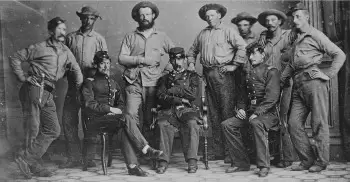

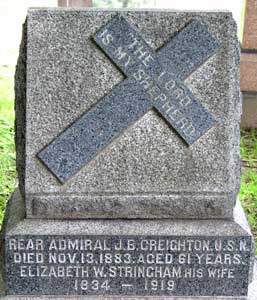
CREIGHTON, JOHNSTON BLAKELEY (1822-1883). Commander, United States Navy. Born in Rhode Island, he was the son of Admiral Johnston Orde Creighton. Creighton entered the United States Naval Academy in 1838. In 1840, he was assigned to the West Indies, was promoted to passed midshipman in 1844, and rose to midshipman in 1849, serving off the coast of Brazil and later, Africa. After duties in the Pacific and Mediterranean, he was commissioned lieutenant, and returned to the naval yard in Charlestown, Massachusetts. In 1862, he took command of the steamer Ottawa and later the Mahaska, engaging in the South Atlantic blockade. His commands included the bombardment of Forts Wagner (South Carolina) and Gregg (Virginia), and while in command of the steamer Mingo, he took possession of Georgetown, South Carolina.
Commissioned captain in 1868, he was assigned to special duty in New York City until 1871, then served in the Asiatic Squadron, and was commissioned commodore in 1874. The New York City Directory for 1870-1873 lists him as being in the United States Navy; at that time, his home address was 106 Hicks Street. Creighton served at the navy yard in Norfolk, Virginia, from 1876 until 1878, and made his last cruise in 1881. An online biography notes that he also served on the following ships during his career in the Navy: USS Cumberland, USS North Carolina, USS Oneida, USS Worcester and the USS Guerrier. According to the census of 1870, he was living in Brooklyn and was a captain in the Navy; the census of 1880 records his rank as commander.
Retiring from service in 1881, Creighton made his home in Morristown, New Jersey. His death certificate lists his rank as rear admiral. He was survived by three children; two children from his first wife predeceased him. Shortly after his death, Elizabeth Creighton, his second wife, whom he married in 1869 and who is interred with him, applied for and received a pension of $30 a month from the Navy, certificate 3,170. (His first wife, Edwina, was Elizabeth’s sister. Both wives were the daughters of Rear Admiral Silas Stringham (see) who is buried in the same lot.) On May 6, 1933, Abbie Creighton, his daughter with his second wife, wrote to President Franklin D. Roosevelt asking for a pension from the Navy based on the service of her father and paternal and maternal grandfathers, citing her age and lack of income; her request was denied. A collection of his correspondence is held at East Carolina University in Greenville, North Carolina. Section 92, lot 439.
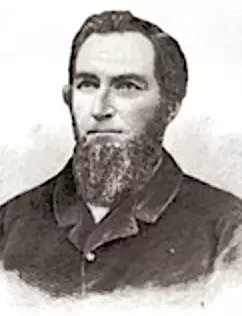
.
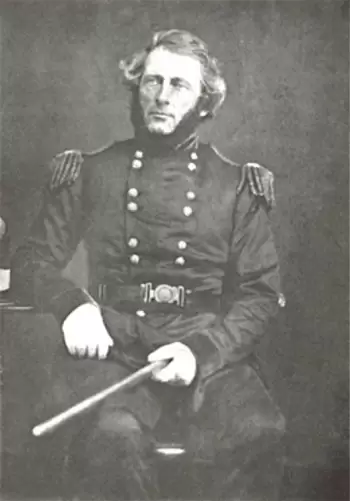
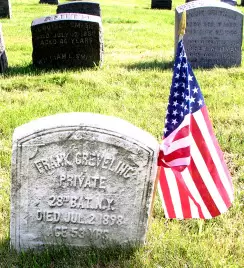
CREVELING, FRANK (or FRANCIS) (1845-1898). Private, 28th New York Light Artillery. A native of New York City, Creveling enlisted on August 24, 1864, at Tarrytown, New York, and mustered in on that date. A trunk maker by trade, he was 5′ 10¾” tall with brown hair, blue eyes and a fair complexion. He mustered out on July 31, 1865, at New York City. Although Creveling re-enlisted in the United States Army on March 22, 1870, he deserted at Fort Columbus, New York, on May 13, 1870. The Brooklyn Directory for 1888-1890 lists his occupation as shoemaker. The Veterans Schedule for 1890 confirms his military service. Shortly after his death from nephritis in 1898, Jessie Creveling applied for and received a widow’s pension under certificate 490,644. Section 134, lot 29725, grave 307.
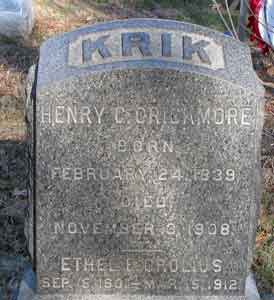
CRICKMORE, HENRY GOLE (or C.) (1839-1908). Major, 4th Regiment, United States Colored Cavalry, Company D; sergeant and color bearer, 8th Regiment, New York State National Guard, Company B. Of English origin, Crickmore was a printer by trade. After enlisting as a sergeant at New York City on May 29, 1862, he mustered into the 8th Regiment that day, and mustered out after three months at New York City on September 10. He was a sergeant and color bearer in the 8th Regiment when it was activated for 30 days in 1863. Subsequently, he served in the 4th U.S. Colored Cavalry, which was organized from the 1st Corps d’Afrique Cavalry on April 4, 1864. Attached to the defenses of New Orleans, Louisiana, he joined the unit as a captain and was promoted to major during his tenure. The 4th was engaged in actions in Louisiana and the Department of the Mississippi before it mustered out on March 20, 1866.
Crickmore remained in New Orleans after the Civil War, was employed as a turf writer for The New Orleans Picayune and was active in Reconstruction politics. Listed in the Who’s Who in New York, he became the turf editor of The New York World in 1871 and published Krik’s Guide to the Turf, the most authoritative guide to horse racing published at that time. During his tenure with the World, he was also a baseball editor. After resigning his post at the World in 1890, he was employed by the Monmouth Park Racing Association and was an officer of the New York Racing Association. He also belonged to the Washington, Brooklyn, and Coney Island Jockey Clubs. He last resided at the Belmont Hotel in Manhattan. His death was caused by pneumonia. His funeral took place at Grace Church. As per his obituary in the New York Herald, newspapers in New Orleans, Baltimore and Washington, D.C. were asked to print notices of his death. Section 102, lot 21606, grave 3.
CRISSEY, LYMAN D. (1829-1906). Sergeant, 95th New York Infantry, Company H. After enlisting as a sergeant at New York City on September 9, 1861, Crissey mustered into the 95th New York on November 1, and was discharged for disability at a hospital in Rhode Island on May 1, 1863. In the New York City Directory of 1869 and again in the United States census of 1880, he was listed as a painter. In 1880, he was living in Jersey City, New Jersey. In 1887, his application for an invalid pension was approved, certificate 710,928. By 1890, he was a widower living at the Soldiers’ Home in Kearny, New Jersey, where he died 16 years later. His death was attributed to hemiplegia and senility. Section 189, lot 18910, grave 3.
CROATMAN, CHARLES (1838-1869). Sergeant, 5th New York Infantry, Company C. Croatman was born in New York City where he enlisted as a private on April 27, 1861. After mustering into Company C of the 5th New York on May 9, he was promoted to corporal on October 29, 1861, and to sergeant on December 27. He deserted from Camp Federal Hill in Baltimore, Maryland, on February 13, 1862. His last residence was in New York City. His death was caused by drowning. Section 85, lot 3667, grave 227.

CROCKER, GEORGE AUGUSTUS (1831-1906). Captain, 6th New York Cavalry, Company A; first lieutenant, 5th New York Cavalry; private, 7th Regiment, New York State Militia, Company D. Born in Massachusetts, he enlisted in the 7th for its 1861 activation, which lasted from April 19-June 3, 1861. Later that year, he re-enlisted as a first lieutenant at New York City on September 11 and was immediately commissioned into the 5th New York Cavalry. On October 11, he was promoted to adjutant and transferred into the 6th New York Cavalry. On December 4, he returned to the rank of first lieutenant, and became captain of Company A on June 27, 1862. He served as an aide on the staff of Generals Keyes, Sickles, Pleasanton, and Buford and as an acting inspector general of the First Cavalry Division, Army of the Potomac. After he was captured at Brandy Station, Virginia, on October 11, 1863, he was exchanged at Wilmington, North Carolina, on March 1, 1865, and discharged two months later on May 15. Crocker last resided at 5 West 49th Street in Manhattan. The cause of his death was arteriosclerosis. Section 4, lot 17936.
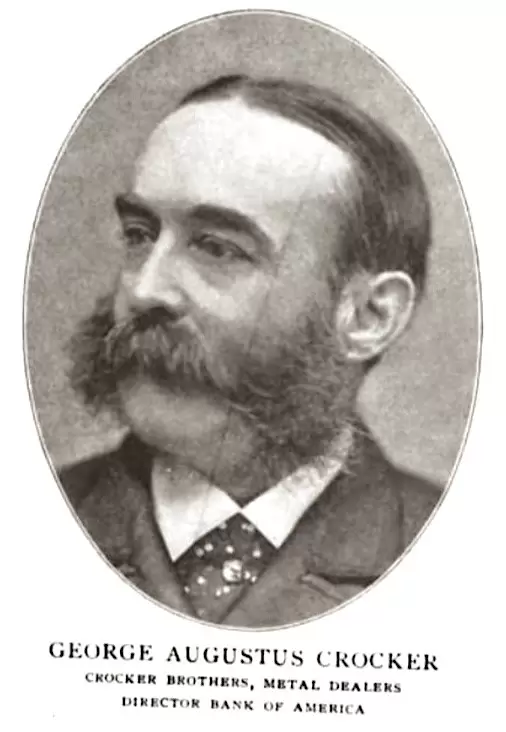
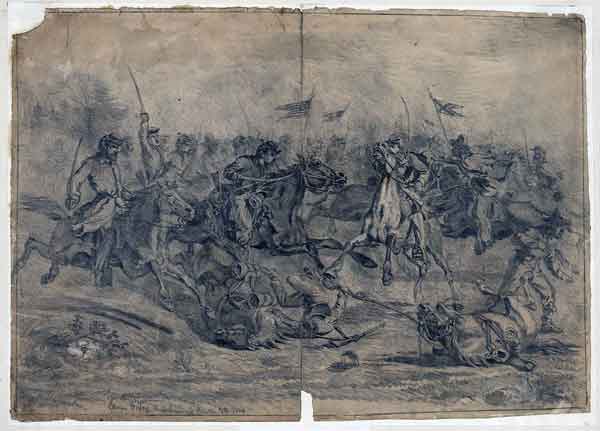
CROCKER, WILLIAM H. (1832-1880). Lieutenant colonel, United States Volunteers; major, 6th New York Cavalry, Company I. According to the census of 1860, Crocker, a native New Yorker, lived in Morrisania, New York, and was employed as a merchant. After enlisting as a captain on October 12, 1861, at New York City, Crocker was commissioned into Company I of the 6th New York Cavalry on November 15. He was promoted to major and transferred to the Field and Staff on November 7, 1862, and was commissioned into the United States Volunteers Inspector General’s Department on June 10, 1863, with the rank of lieutenant colonel and assistant inspector general. He then requested to go back to his regiment where he took command. The following month he rose to lieutenant colonel on July 31.
Commanding officer Major General A. Pleasanton in his report of August 31, 1863, including the Battle of Gettysburg, Pennsylvania, praised Crocker and other officers noting that they “…were conspicuous for the zeal, intelligence, and daring with which they discharged their arduous and dangerous service, not unfrequently (sic) having to pass through the enemy’s forces to reach our own…” In 1864, he commanded the 6th New York Cavalry at the following Virginia battles: Wilderness (May 5-7), Spotsylvania Court House (May 8-21), General Sheridan’s Expedition from Todd’s Tavern to James River (May 9-24), Totopotomoy (May 27-31), Cold Harbor (May 31-June 12), General Sheridan’s Trevilian Raid (June 7-24), and Trevilian Station (June 11-12). He was discharged on December 29, 1864. According to William Swinton’s History of the Seventh Regiment (1876), Crocker served in Company D of that unit; it is not clear when his service took place.
The census of 1870 lists his occupation as stationer. A Freemason, his last residence was in Montclair, New Jersey. He died from Bright’s disease. In 1885, his widow, Eliza Crocker, was granted a pension, certificate 229,061. Section 189, lot 10058.

CROLIUS (or CROLIOUS), GEORGE H. (1837-1875). Private, 11th New York Infantry, Company H. A native New Yorker and a sail-maker according to the census of 1860, following in the trade of his father, George Clinton Crolius, he enlisted there as a private on April 20, 1861, mustered into the 11th New York on May 7, and mustered out at New York City a year later on June 2, 1862. A notation on the muster roll indicates that he was reported as deserted with the matter taken up by order of the Secretary of War and that he was borne on the New York State payroll but not paid. A brother, Erastus, served in the 11th Regiment; another brother, William A. Crolius (see), served in the 5th and 146th New York. The 1870 census shows that he was a sail-maker by trade. His last residence was on Beach Street in Manhattan. Crolius died from phthisis. Section 15, lot 17263, grave 1002.
CROLIUS (or CROLIOUS), JAMES WESTERVELT (1848-1925). Sergeant, 11th New York Infantry, Companies B and C. After enlisting as a private on April 20, 1861 (it appears that he lied about his age in order to enlist), he mustered into Company B of the 11th New York on May 7, and was transferred into Company C on October 12 of that year. At some point in his service he was promoted to sergeant. On January 31, 1862, he was discharged for disability at Newport News, Virginia.
The Brooklyn Directories for 1873-1876 and 1888-1890 note that he was a weigher. Although he applied for a pension in 1896, application 1,177,588, there is no certificate number. According to the 1900 census, he was a cotton weigher; the censuses of 1910 and 1920 show that he was employed in the cotton business. His last address was 1097 East 22nd Street in Brooklyn. He died from pneumonia. Section 80, lot 5051.
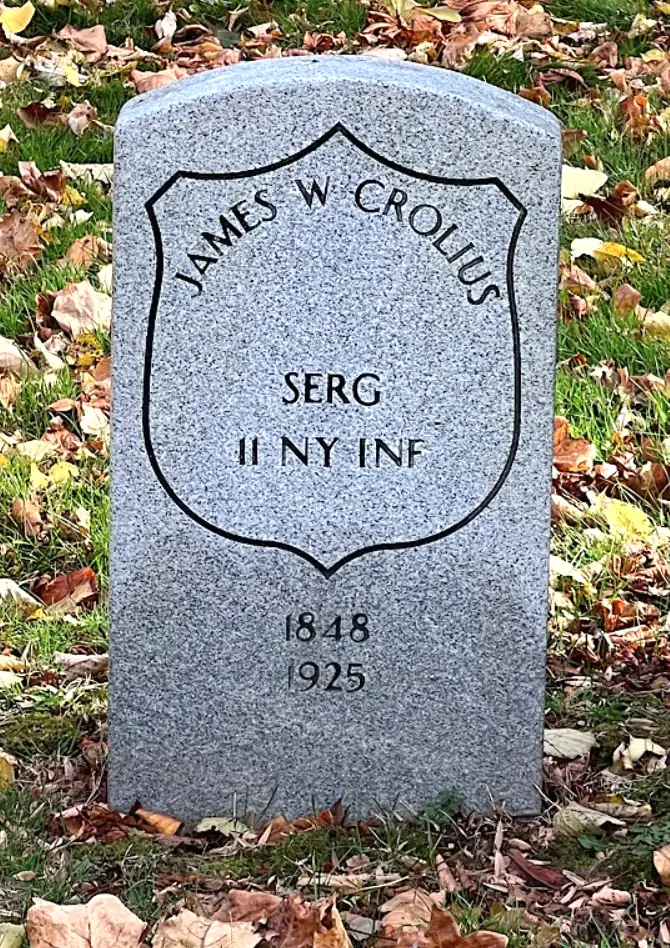
CROLIUS (or CROLINS, CORLISS), WILLIAM A. (1843-1901). private, 5th New York Infantry, Company G, 146th New York Infantry. Although listed in the Green-Wood database as William A. Crolius, he is identified as William Crolius in online biographies. A native of New York City, the census of 1860 states that he was employed as an apprentice bookbinder. He was a brother of George Crolius (see) and Erastus, who served in the 11th New York; he had six other siblings. Crolius, also known on soldier records as William A. Corliss, enlisted at New York City on August 26, 1862, the same date that he mustered into Company G of the 5th New York. A bookbinder by trade, he was 5′ 7″ tall with blue eyes, light hair and a light complexion. He was transferred into the 146th New York (unassigned company) on May 4, 1863, from which he was discharged on an unknown date.
According to the census of 1880, he was a notary. He last lived in Manhattan. He was survived by his widow, Grace Josephine (née Crouch); the couple had three children. Section 17, lot 17245.
CROLIUS (or CROLINS, CORLISS), WILLIAM ALBERT (1832-1920) Private, 158th New York Infantry, Company E. He enlisted as a private at Brooklyn on July 30, 1862, mustered into the 158th on August 31, and deserted at Brooklyn on September 18 of that year. He was 5′ 5″ tall with auburn hair and eyes and a dark complexion. At the time of his death, he was a resident at the Home of Aged Men at 745 Classon Avenue in Brooklyn. His death was attributed to senility. Section 109, lot 46.
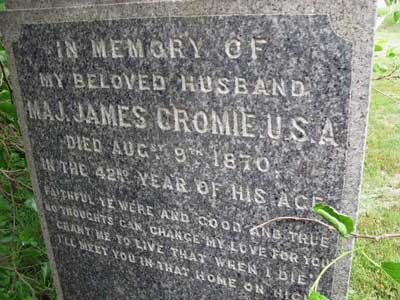
CROMIE, JAMES (1830-1870). Captain, 12th Regiment, New York State Militia, Company F; 12th New York Infantry, Company F. Of Irish origin, Cromie enlisted as a captain at New York City on April 19, 1861, was commissioned into the 12th Regiment on May 2, and mustered out after three months on August 5 at New York City. He re-enlisted on October 1, 1861, and was commissioned into the same regiment and company on December 9. Cromie was severely wounded in the right shoulder at Gaines’ Mill, Virginia, on June 27, 1862, and taken as a prisoner of war that same day. On August 27, 1862, he was exchanged for Jesse Miller of the 31st North Carolina Infantry, and resigned on April 7, 1863, citing disability. The soldier record states that his right arm was “useless” at the time he mustered out. In 1869, his application for an invalid pension was approved under certificate 97,891. Although his widow applied for a pension, application 379,387, there is no certificate number. He died from congestion of the bowels. Section 107, lot 10187.
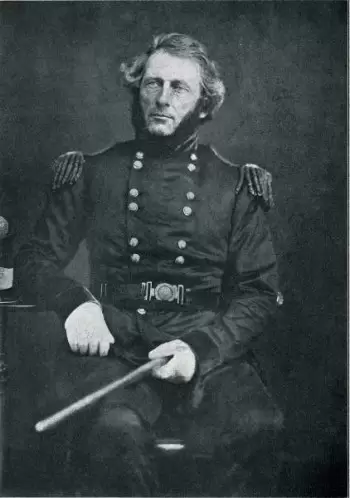
CROOKE, PHILIP SCHUYLER (1810-1881). Brigadier general, New York State National Guard and Congressman. Born in Poughkeepsie, New York, his ancestors established roots there in 1670. After being educated at the Dutchess Academy, Crooke studied law, passed the bar. and established a law practice in Brooklyn in 1832. He was a member of the Board of Supervisors of Kings County from 1844 to 1852 and then again from 1858 through 1870, serving as its chairman in 1861, 1862, 1864 and 1865. He served as an elector for the Democratic presidential candidate, Franklin Pierce, in 1852.
As per a biography of Crooke in the Brooklyn Standard Union in 1872, he changed his registration from the Democratic Party to become an independent in 1854. Just before then, as a member of the Democratic State Central Committee, he strenuously opposed a resolution in favor of allowing slavery in the territories of the United States; that resolution was supported by many other Democrats. He is listed as a lawyer at 347 Fulton Street in the Brooklyn Directory for 1857-1862. During the Presidential election of 1860, he supported Abraham Lincoln’s candidacy.
During the Civil War, Crooke commanded the Fifth Brigade, National Guard, in Pennsylvania during June and July of 1863. In his report to headquarters on December 1, 1863, he wrote about the events of the previous June 15-July 19, “The Fourteenth Regiment is, and has been since May, 1861, in the United States service, in the Army of the Potomac; has distinguished itself for courage and endurance in many a hard-fought battle-field and many a wearisome march; its reputation is part of the history of the country, and all the battles of the Army of the Potomac record its bravery and good service…” His troops manned the defenses at Harrisburg, Pennsylvania, then returned to New York after the Battle of Gettysburg.
After he switched political parties, he was elected a member of the New York State Assembly as a Republican in 1864. The Brooklyn Directories for 1863, 1864, 1865 and 1867-1870 list him as a supervisor of Flatbush and as a lawyer, first at 347 Fulton Street and in the last listed directory at 151 Montague Street. Elected as a Republican to the United States Congress, he served one term (1873-1875), then resumed his law practice. He said in 1872 of his political beliefs, “Since I left the Democratic party, I have not taken any factious part in politics, but have supported the side I believed to be right and the men I believed to be right without regard to party. I learned twelve years ago that to attempt to carry out right principles with bad men was like making bricks without straw.”
During his lifetime, Crooke served for 40 years in the New York State National Guard, rising from private to brigadier general. His son, Robert Livingston Crooke (see), also served in the War. His last residence was in Flatbush, Brooklyn. His residence was the historic Jans Martense Schenck house, which was inherited by his wife. He was survived by three children; his wife, Margaret Caton Crooke, who is interred with him, died in 1858. His home was later known as the Martense-Crooke house; the original two-room portion of his home was rebuilt at the Brooklyn Museum. Section 74, lot 11089.
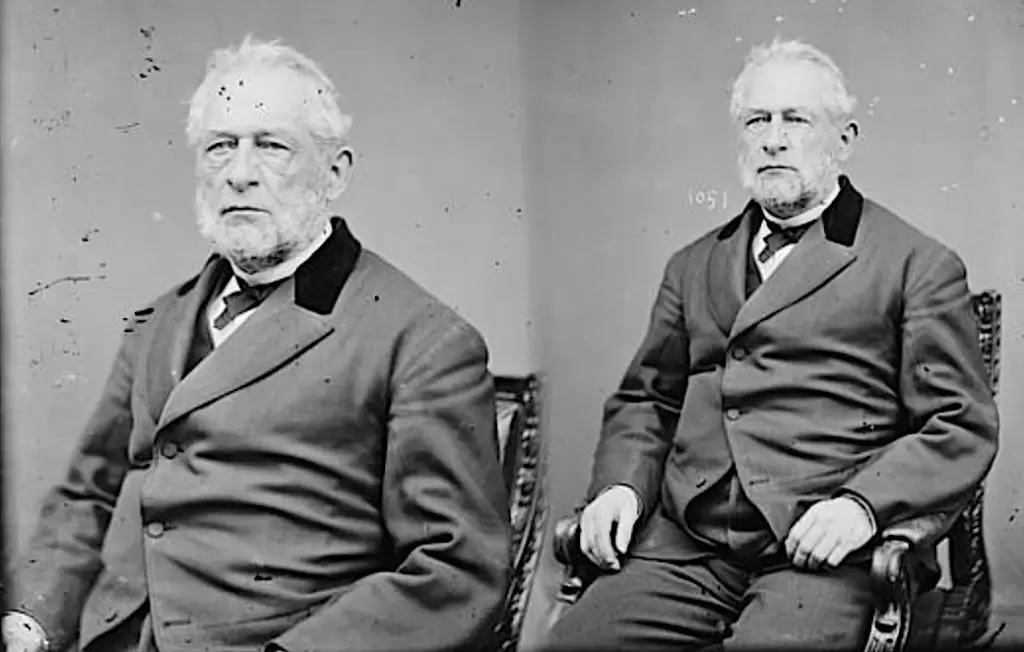
CROOKE, ROBERT LIVINGSTON (1840-1916). Private, 13th Regiment, New York State Militia, Company B. The son of General Philip Schuyler Crooke (see), he was a native of the Flatbush section of Brooklyn. He served for three months in 1861 in the 13th New York State Militia.
After the Civil War, Crooke owned a lead manufacturing plant in Brooklyn on Flatbush Avenue near Jamaica Bay, and summered in Huntington, Long Island. The Brooklyn Directory for 1880-1882 lists him as a refiner and the 1882-1883 New York City Directory reports that he was the president of Crooke Smelting and Refining Company at 22 Burling Slip and West 15th Street; at that time, he lived at 108 Joralemon Street. He last lived in North Salem, New York. His death was attributed to chronic Bright’s disease and pyelitis. As per his obituaries in the New York Tribune and the New York Herald, his funeral took place at the chapel at Green-Wood Cemetery. Section 74, lot 11089.
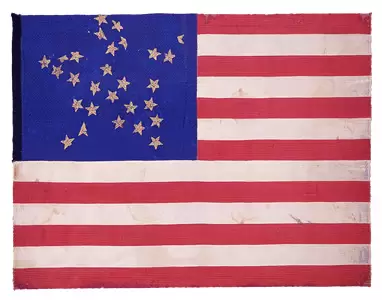
CROPSEY, JOHN W. (1828-1882). Lieutenant colonel, 14th New York Cavalry, Company C. A native of New York, Cropsey was a policeman as per the census of 1860. He was 6′ tall with blue eyes, dark hair and a light complexion. He enlisted at New York City on December 20, 1862, as a captain, and on that date was commissioned into the 14th New York Cavalry. He was commissioned lieutenant colonel on August 23, 1863, with rank from July 10, 1863, and tendered his resignation on October 1, 1864.
According to the censuses of 1870 and 1880, Cropsey was a police officer. He is listed as working for the police in the 1876-1878 New York City Directory; at that time, he lived at 94 Barrow Street. He last lived at 440 West 20th Street in Manhattan. He succumbed to cancer. He was survived by his wife, Rebenia, and two children. Section 105, lot 2767.
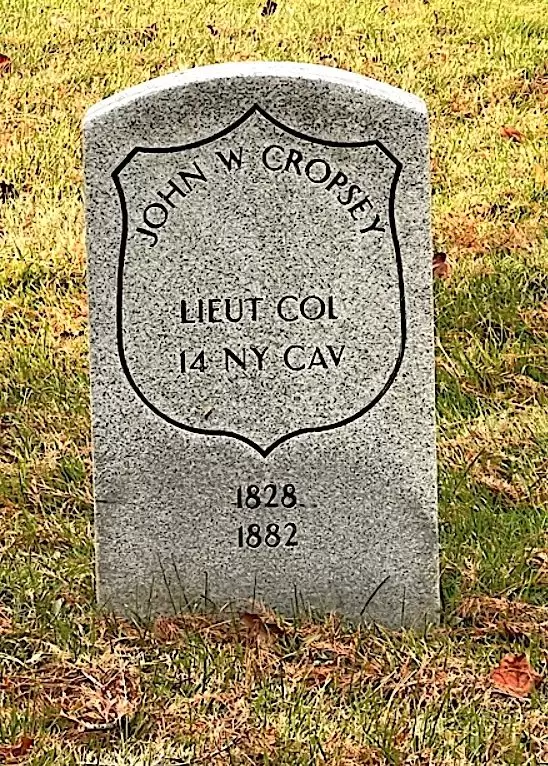
CROPSEY, WILLIAM J. (1826-1912). Colonel, 70th Regiment, New York State National Guard. Born in the village of New Utrecht in what is now part of Brooklyn, William Cropsey’s Dutch ancestors settled in Brooklyn more than three hundred and fifty years ago. As per his obituary in the Brooklyn Daily Eagle, the family homestead was situated on Gravesend Bay between Bath Beach and Fort Hamilton. His first worked as a farmer. In addition, he was a supervisor for the town of New Utrecht for a number of terms from 1859 through 1870. In the early 1860s, he was a member of the Kings County Troop, which became part of the 70th Regiment, New York State National Guard. Cropsey mustered into the 70th New York National Guard in February 1863, and his unit saw service in Brooklyn during the New York City Draft Riots in July of that year.
Cropsey was instrumental in the creation and observance of the third New Utrecht Liberty Pole in May 1867. The Liberty Pole commemorated Evacuation Day, the day the British troops left the Colonies on November 25, 1783. Cropsey had a long career with the United States Custom House in New York. He served as postmaster of Fort Hamilton at the entrance to New York Harbor from 1875-82. He died at the residence of his son, District Attorney J. A. Cropsey, at 1700 Albemarle Road in Brooklyn, where he lived after the death of his wife, Mary Church Cropsey, in 1900. The cause of his death was apoplexy. Section 103, lot 19476.
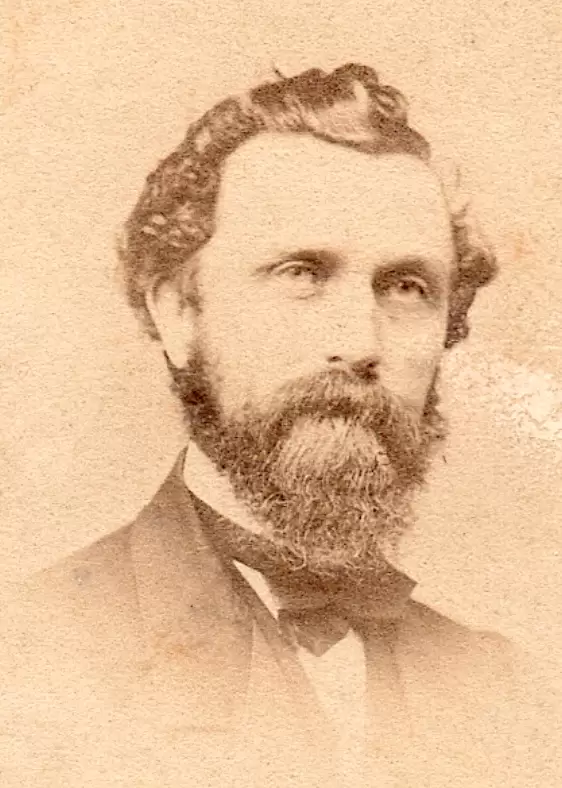

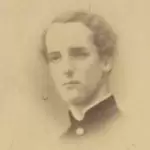
CROSBY, FRANKLIN BUTLER (1840-1863). First lieutenant, 4th Light Artillery, United States Army. Born in New York State, Crosby enlisted on August 8, 1861, as a second lieutenant, and was immediately commissioned into his unit. He was promoted to first lieutenant at some point during his service. His first assignment was to command his battery on May 2, 1863, at the Battle of Chancellorsville, Virginia; he was killed by a sniper the following morning. Among his personal effects was a copy of “The Imitation of Christ,” with the following passage marked: “Fight like a good soldier; and if thou sometimes fall through frailty, take again greater strength than before, trusting in my more abundant grace.”
An article about his funeral was published in The New York Times on May 21, 1863. His funeral took place at the Mercer Street Presbyterian Church where a large crowd gathered. His coffin was made from rosewood and was studded in silver adorned with a plate with his name and life dates. After the service, there was a military escort from the 22nd Regiment of the New York State National Guard and a detachment ninety-five men of 12th United States Infantry. The funeral cortege traveled from 14th Street to Broadway and then on toward South Ferry on its way to Green-Wood.
In June 1863, his poem, One Day’s Command, appeared in Harper’s Weekly. The text appears below:
The plumed staff officer gallops
Along the swaying line,
That shakes as, beaten by hailstones,
Shakes the loaded autumn vine;
And the earth beneath is reddened,
But not with the stain of wine.
The regular shock of a battery
The rattling tumult stuns;
And its steady thrill through the hill-side
Like a pulse beneath it runs;
The many are dead around it,
But the few still work the guns.
“Who commands this battery?”
And Crosby his clear, young eyes
From the sliding gun-sights lifting
As the well-aimed death-bolt flies,
“I command it today, Sir!”
With a steady voice replies.
Answers as heroes answer,
With modest words and few,
Whose hearts and hands to duty
Even in death are true,
Though its awful light is breaking
Full on their blenchless view.
The officer passes onward
With a less troubled eye,
The words and the look unshaken
Bid every wild doubt fly;
He knows that the young commander
Is there to do or die.
To do and die; for the battle
And day of command are done,
While stands unmoved on the hill-side
Each shattered, blackened gun,
And Crosby in death beside them
A deathless name has won.
William Allen Butler, a Civil War poet from Newport, Rhode Island, wrote this eulogy to his nephew:
Franklin Butler Crosby
Chancellorsville, May 3, 1863
He was our noblest, he was our bravest and best!
Tell me the post that the bravest ever have filled.
The front of the fight! It was his. For the rest–
Read the list of the killed.
On the crown of the ridge, where the sulphurous crest
Of the battle-wave broke, in its thunder and flame,
While his country’s badge throbbed with each beat of his breast,
He faced death when it came.
His battery planted in front, the Brigadier cried,
“Who commands it?” as fiercely the foe charged that way,
Then how proudly our gallant Lieutenant replied,
“I command it to-day.”
There he stood by his guns; stout heart, noble form,
Home, and its cherished ones never, never so dear,
Round him the whirlwind of battle, through the wild storm, Duty never so clear.
A painting of Franklin Butler Crosby is in a collection of Civil War portraits at the Bancroft Library at the University of California, Berkeley. He was interred in Green-Wood on May 20, 1863. Two memorial books were published about him–Tell Mother, I Die Happy: the Last Words of Lieutenant Crosby, a collection of ten illustrated songs, published by Charles Magnus (1863) and A Memorial of Lieutenant Franklin Butler Crosby by Robert Russell Booth (1864). Section 96, lot 96.
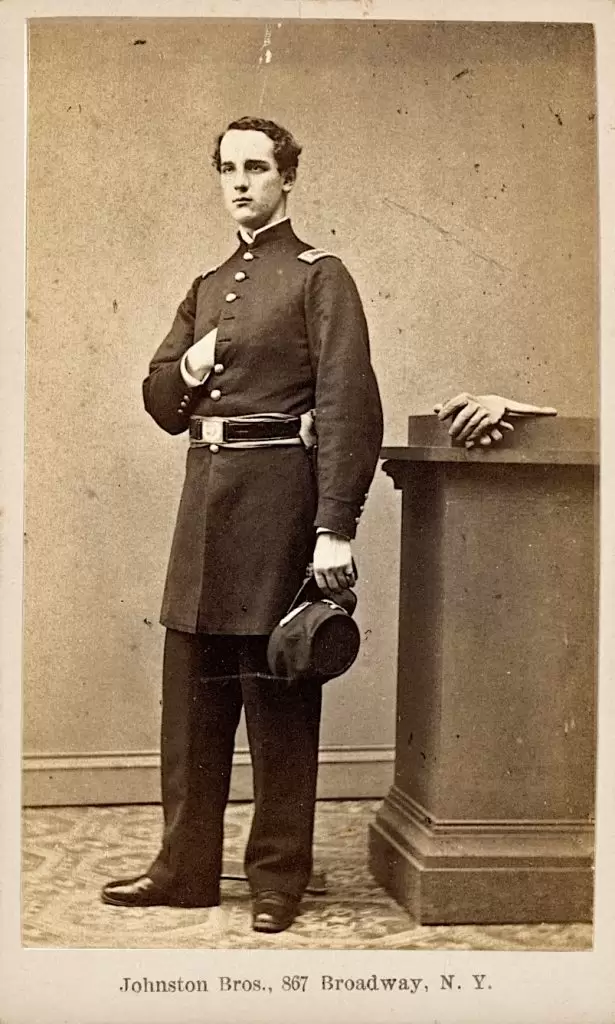
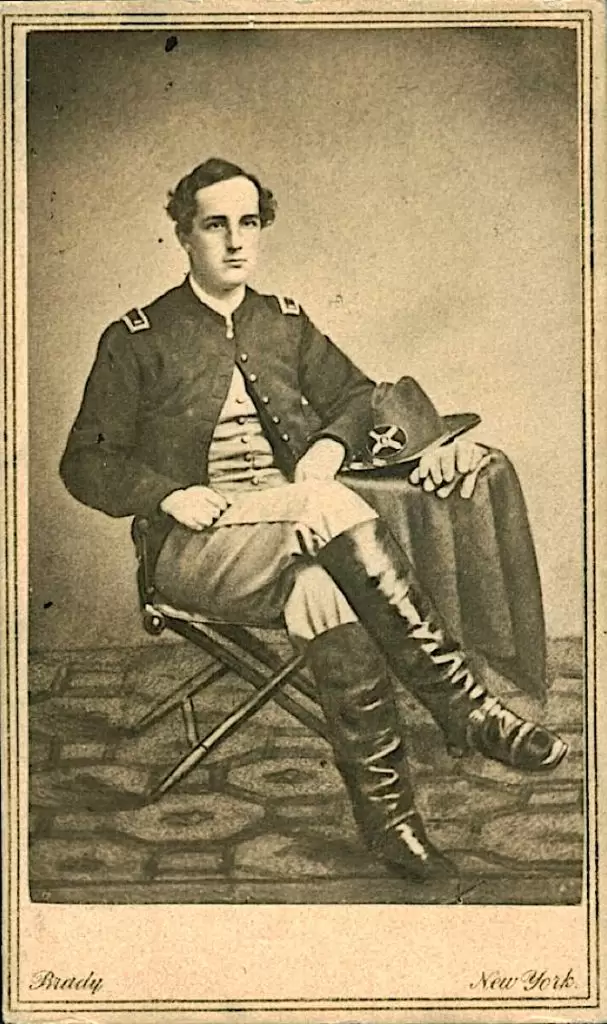
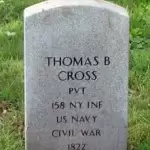
CROSS, THOMAS B. (1822-1882). Private, 158th New York Infantry, Company E. A native of England and an engineer at the time of his enlistment, Cross was 5′ 7½” tall with blue eyes, brown hair and a florid complexion. He enlisted at Brooklyn as a private on January 30, 1864, mustered immediately into the 158th New York, and transferred into the Navy on May 13, 1864.
Cross is listed as a chemist in the Brooklyn Directories for 1873-1876 and 1877: he worked at 53 Park Place in Manhattan and lived at 419 Pulaski Street in Brooklyn. According to the 1880 census, he was employed in the drug business. His last address was in Passaic, New Jersey. Section 189, lot 17778. According to the 1880 census, he was employed in the drug business. His last address was in Passaic, New Jersey. He succumbed to cancer. Section 189, lot 17778.
CROSS (or CROSE), WILLIAM HENRY (1847-1925). Private, 139th New York Infantry, Company F. Of English origin, Cross enlisted as a private at Brooklyn on August 21, 1862, and mustered into the 139th New York on September 9. He mustered out on June 19, 1865, at Richmond, Virginia. In 1908, he applied for and received an invalid pension, certificate 1,148,554. He was living in New Jersey at the time of the 1920 census. Cross last lived in Long Valley, New Jersey. He died from a stroke. Shortly after his death in 1925, Mary Cross applied for and was granted a widow’s pension, certificate 967,027. Section 196, lot 31508, grave 3.
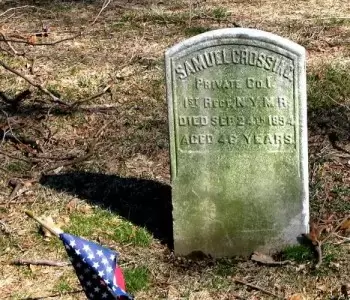
CROSSING, SAMUEL F. (1848-1894). Private, 1st New York Mounted Rifles, Companies G and I. Originally from England, he was 5′ 8½” tall with blue eyes , brown hair, and a fair complexion. A cabinet-maker by trade, Crossing enlisted as a private on August 14, 1862, at New York City, claiming that he was age 18, and mustered into Company G of the 1st New York Mounted Rifles the same day. The muster roll indicates that he was sick on October 31, 1863. At some point, he was transferred within the regiment to Company I.
Crossing is listed in the 1868 Brooklyn Directory as a clerk who lived at 524 Atlantic Avenue. His application to become a naturalized citizen was filed in 1868. He is listed as a clerk in the 1867-1870 and 1873-1876 Brooklyn Directories. The census of 1870 notes that Crossing was employed as a bookkeeper. An article in The New York Times on April 20, 1876, states that he was elected a vestryman in the All Saints’ Church in Brooklyn. As per the 1880 census, he was a manufacturer of multi-grams. The New York City Directory for 1882-1883 notes that he was president of a company at 252 Broadway and lived at 335 12th Street in Brooklyn. According to the Brooklyn Directory of 1888-1890, he was a bookkeeper and is listed as being in the multi-grams business in the New York City Directory for 1891-1892. The Veterans Schedule of 1890 confirms his military service. In 1890, he successfully applied for an invalid pension, certificate 643,039.
An article in the Brooklyn Daily Eagle in 1894 states that Crossing was arrested for indecent exposure and jumped bail; no other information is available. His last residence was 234 7th Avenue in Brooklyn. His death was attributed to accidental burns. Emma Crossing applied for and received a widow’s pension after his death in 1894, certificate 406,243. Section 143, lot 28402, grave 3.
CROUCH, WILLIAM THOMAS (1840-1918). Sergeant, 13th Regiment, New York State Militia, Company D. A New York City native, Crouch first served in the 13th Regiment in 1858. In 1861, he served for three months as a first sergeant with Company D of the 13th New York State Militia after enlisting on April 23, 1861. After recruiting in Brooklyn, he re-enlisted there as a private on May 28, 1862, mustered immediately into the 13th Regiment (part of the National Guard), and was later sent home from Suffolk, Virginia, to recuperate from hemorrhages of the lungs and camp fever. After his convalescence, Crouch resumed recruiting in New York City and later was detailed to care for the sick and wounded at Fort Hamilton, Brooklyn, remaining in that job for eight months.
He may be the William T. Crouch who is listed as a clerk in the 1863 and 1864 Brooklyn Directories; that man lived at 283 Schermerhorn Street during those years. Subsequently, he was employed in the Department of Water, Gas and Electricity and was also a charter member of Ulysses S. Grant Post #327 of the G.A.R. He was part of the honor guard at Albany, New York, for President Ulysses S. Grant’s funeral. He then participated in ceremonies when Grant’s body was at City Hall in New York City and in the procession and burial at Riverside Park. In 1895, he applied for and was granted an invalid pension, certificate 1,002,342. As per his obituary in the Brooklyn Daily Eagle, members of the 13th Veterans were requested to attend his funeral; comrades were asked to arrive in uniform. He last lived at 50 Greene Avenue in Brooklyn. The cause of his death was arteritis, inflammation of the walls of the arteries. Section 62, lot 4105.
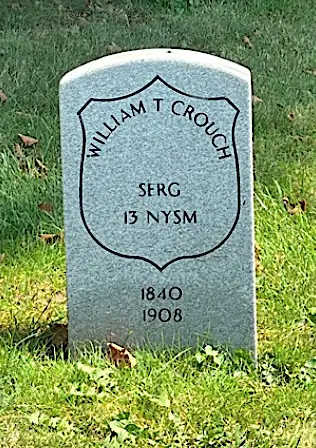
CROUT, DAVID (1839-1875). Private, 55th New York, Company E; 38th New York Infantry, Company G; 40th New York Infantry, Company A; Veteran Reserve Corps. Born in New York City, he enlisted there on March 14, 1862, and immediately mustered into the 55th New York. Subsequently, he transferred into the 38th New York on December 21, 1862, and transferred into the 40th New York on June 3, 1863. On October 15, 1863, he transferred into the Veteran Reserve Corps, where he served in the 2nd Battalion and the 18th Regiment. His last residence was in New York City. His death was attributed to cirrhosis. Section 59, lot 1657.
CROW, JOHN (1848-1909). Musician, 74th New York Infantry, Company I; 40th New York Infantry, Company H. A New Yorker by birth and brother of Nimrod (see), he enlisted as a private on November 1, 1861, at New York City, claiming to be 16, and mustered into the 74th New York Infantry on December 28. He served as a drummer in the regiment, and was transferred into the 40th New York Infantry on August 3, 1864, when that regiment was organized and comprised of men from the 40th New York. He was promoted to musician at some point before he mustered out on October 20, 1864, at Petersburg, Virginia, at the expiration of service.
According to the censuses of 1870 and 1900, he was a stone-cutter by trade, following in the footsteps of his father. He is likely the John Crow who is listed as a cutter in the 1875-1876 and 1877 New York City Directories. His last residence was on East 33rd Street, Manhattan. He died from tuberculosis. Section 61, lot 3664.
CROW, NIMROD (1837-1905). Private, 11th New York Infantry, Company H. The elder brother of John Crow (see), he was born in Washington, D.C. He enlisted as a private at New York City on April 20, 1861, mustered into the 11th New York on May 7, and deserted on August 1, 1861. The muster roll notes that he was borne on the State payroll but not paid as of September 9 of that year.
Like his brother and father, Nimrod Crow was a stone-cutter by trade as noted in the censuses of 1870, 1880, and 1900. He is listed as working in the stone business in the New York City Directories for 1875-1876 and 1877. At that time, he lived at 124 East 51st Street. Nimrod Crow is listed as an operator in the 1885-1886 Brooklyn Directory. He last lived as a lodger on East 23rd Street in Manhattan. He died from nephritis. Section 61, lot 3664.
CROWELL, MINER B. (or C.) (1821-1896). Acting volunteer lieutenant, United States Navy. According to one source, Crowell was born in England, although other sources document his birthplace as Connecticut. His obituary in the Brooklyn Standard Union notes that he went to sea as a youngster, first serving as a cabin boy and then commanding a ship at age twenty-eight. The 1861 and 1862 Philadelphia Directories list him as a seaman.
After enlisting as an acting master in the Navy on January 18, 1862, Crowell rose to acting volunteer lieutenant for good service on March 16, 1864. He served aboard the USS J. P. Jackson and the USS Augusta Dinsmore. On February 16, 1864, while on the USS J. P. Jackson, he participated in the bombardment of Fort Powell during the campaign at Mobile Bay, Alabama. While aboard the Dinsmore on September 11, 1864, he was in command when the British schooner, John, was apprehended near Galveston, Texas, and its cargo of 81 bales of cotton was seized and shipped to New Orleans, Louisiana, for adjudication. On October 28, 1864, the Dinsmore, with Crowell aboard, helped other Union ships intercept another British ship, the Cora Smyser, as it was trying to deliver cargo to San Luis Pass, Texas. His obituary notes that he served as a lieutenant-commander under Admiral David Farragut. Crowell was honorably discharged on December 18, 1865.
Crowell’s obituary reports that he came to New York City after the Civil War and rose to commodore of the Mallory steamship fleet which plied the waters from New York City to Galveston, Texas. On September 24, 1886, he became a member of the Farragut Association of Naval Veterans of Morgan Post #307 of the G.A.R. He is listed as a shipmaster in the 1888-1890 and 1890-1892 Brooklyn Directories; the latter directory reports that he lived at 179 Garfield Place. In 1891, he applied for and received an invalid pension from the Navy citing defective sight, rheumatism and kidney trouble; it was approved under certificate 17,739. At the time of his death, his monthly pension was $12.
Crowell, who was an active Republican in politics, also belonged to the Military Order of the Loyal Legion, a patriotic organization of Union officers, the Shipmasters’ Association of New York and the Marine Society of New York. A notice of his death in the New York Herald requested that comrades from the Military Order of the Loyal Legion attend his funeral. He last lived in Brooklyn at 170 Garfield Place. His death was attributed to diabetes and heart failure. A widower, he was survived by two married daughters. His obituary in the New York Herald asked newspapers in Philadelphia to print a notice of his death. Section 203, lot 28756, grave 2.
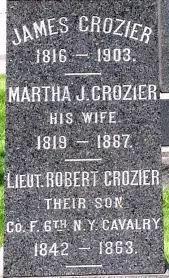
CROZIER, ROBERT (1842-1863). First lieutenant, 6th New York Cavalry, Company F. Crozier, a native of Ireland, enlisted as a second lieutenant at New York City on October 24, 1861, was commissioned on that day into the 6th New York Cavalry, and received a promotion to first lieutenant on June 27, 1862. On May 7, 1863, he was killed in battle at West Point, Virginia. Originally interred on May 16, 1863, his remains were moved to their current location in September 1908. Section 195, lot 30638, grave 1.
CRUICKSHANK (or CRUICKSHANKS), CHARLES (1839-1899). Sergeant, 6th New York Infantry, Company B; private, 13th New York Heavy Artillery, Company A; 6th New York Heavy Artillery, Company H. Of Scottish birth, he enlisted at New York City as a private on April 25, 1861, and mustered into the 6th New York five days later. The muster roll notes that he was paid $11 for his service from April 25-May 25, 1861. He was promoted to corporal on August 3, 1861, and to sergeant on December 4, 1862, serving in that capacity until he mustered out at New York City on June 25, 1863. On July 22, 1863, he re-enlisted as a private at New York City, mustered into the 13th Heavy Artillery on August 12, and transferred into the 6th Heavy Artillery on June 27, 1865. He mustered out on August 24, 1865, at Washington, D.C.
In 1870, the census recorded his occupation as porter; the 1880 census lists his employment as clerk in a shipping house. Cruickshank became a naturalized citizen in 1880; his paperwork for citizenship indicates an honorable discharge from the U.S. Army. In 1890, his application for an invalid pension was approved under certificate 804,967. His last residence was 349 East 65th Street in New York City. Shortly after his death from delirium tremens (confusion often caused by withdrawal from alcohol) in 1899, Matilda Cruickshank (Cruikshank) applied for and received a widow’s pension, certificate 484,871. Section 15, lot 17263, grave 2186.
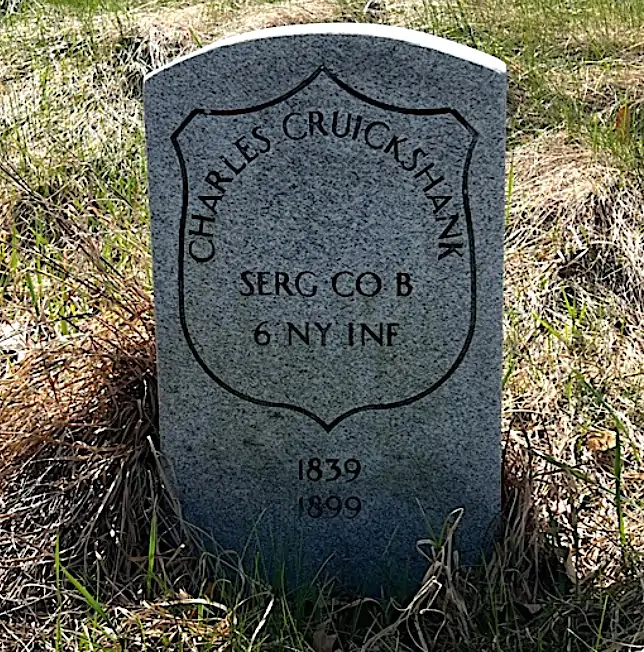
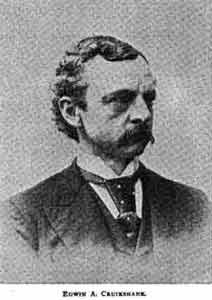
CRUIKSHANK, EDWIN (or EDWARD) ALLEN (1843-1921). Private, 13th Regiment, New York State National Guard, Company C. A Brooklynite by birth, he enlisted there on May 5, 1862, mustered into the 13th that same day, served three months, and mustered out on September 12, 1862.
As per the 1868 Brooklyn Directory, he worked in real estate at 55 Broadway in Manhattan and lived at 201 State Street in Brooklyn. As per the census of 1870, he was a real estate agent whose personal worth totaled $2,000. He is listed as a broker at 68 Broadway in the New York City Directories for 1876-1878, 1880-1882, and 1882-1883. When he applied for a passport in 1886, he was 5′ 10″ tall with a prominent nose, high forehead, blue eyes, brown hair, round face and small chin. An article in the Brooklyn Daily Eagle on September 27, 1889, about a possible World’s Fair in New York notes that Cruikshank was president of the Real Estate Exchange and states that he held it “undesirable and inadvisable to hold the Fair in Central Park.”
The Veterans Schedule of 1890 for Brooklyn confirms his military service. Cruikshank was a founder of the Ulysses S. Grant Post #327 of the G.A.R. He is listed as a broker in the 1891-1892 and 1896-1897 New York City Directories. According to the census of 1900, he was still working as a realtor; by 1910, he had retired. In 1912, his application for an invalid pension was granted under certificate 1,170,940. He last resided at 438 Washington Avenue in Brooklyn. The Evening Post reported that he left an estate valued at $1,126,972, leaving the bulk of his property ($669,000) to his twenty-three -year-old granddaughter. His widow, Susie M. Cruikshank, applied for and received a pension in 1921, certificate 926,759. Section 16, lot 7298.
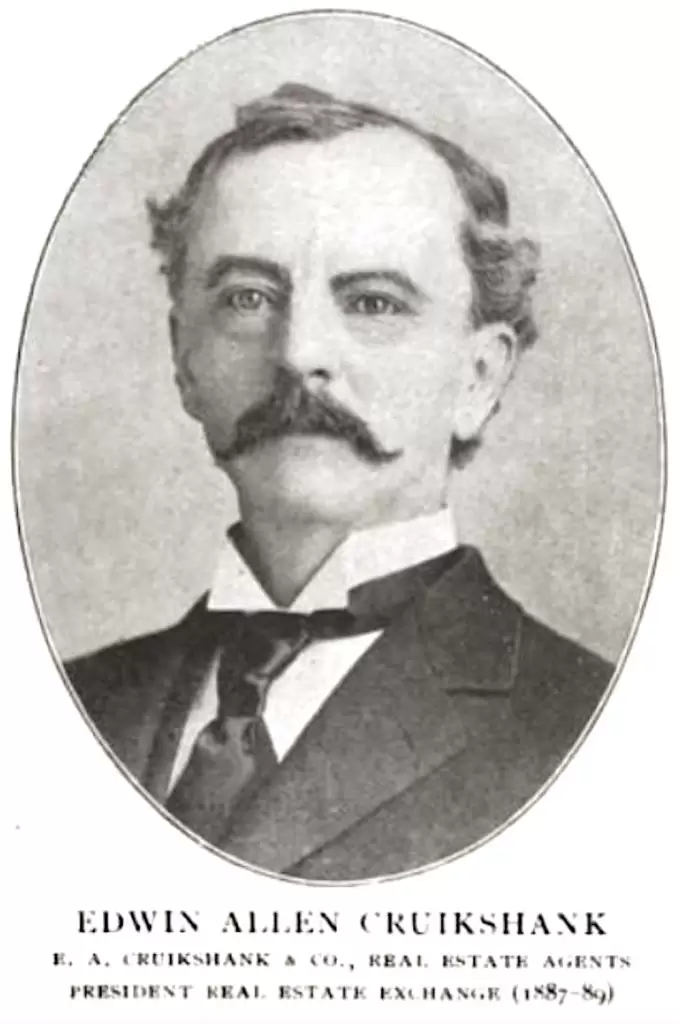
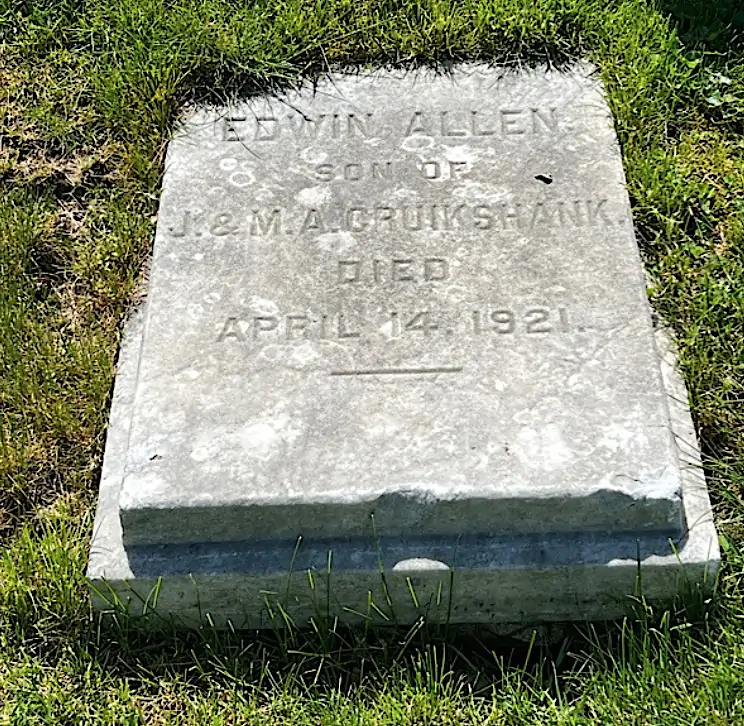
CRUMMEY, THOMAS D. (1838-1929). Third assistant engineer, United States Navy; private, 13th Regiment, New York State Militia, Company B. A native of New York, Crummey was 5′ 4″ tall with blue eyes, brown hair and a fair complexion. A machinist by trade, he enlisted as a private on April 23, 1861, served for three months in the 13th New York State Militia, and mustered out on August 6. On April 21, 1862, he became a third assistant engineer in the United States Navy, first serving aboard the USS Adirondack. On June 10, 1864, he was detached to the Huron; ten days later, he was assigned to the Susquehanna. On August 1, 1866, he became the assistant to Chief Engineer Newell in Norfolk, Virginia, serving until his resignation on September 5, 1866. According to the censuses of 1870, 1900, and 1910, he was an engineer. He received a pension from the Navy under certificate 37,174. He last lived at 960 71st Street in Brooklyn. Crummey died from pulmonary edema. Communications to the Pension Bureau requesting funds for burial and funeral expenses show that he died without any estate or personal property. Section F, lot 18692.
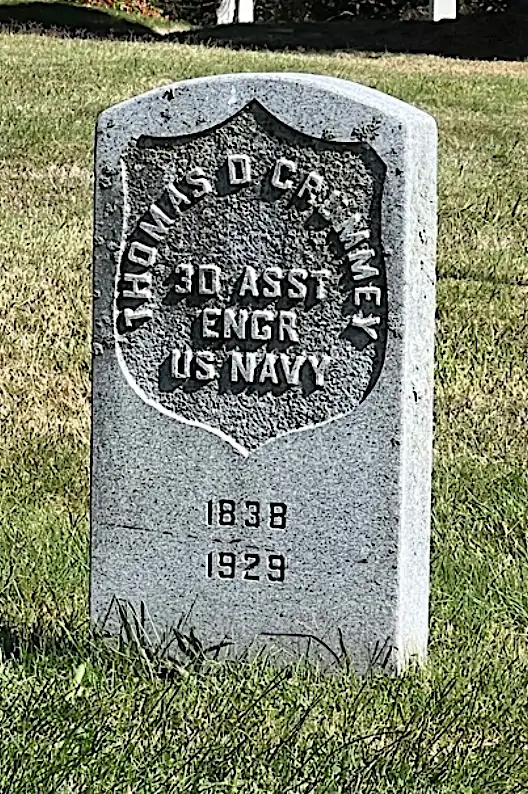
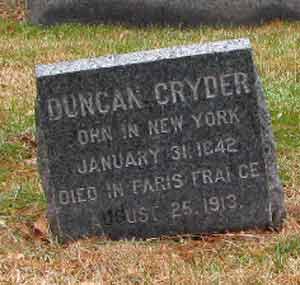
CRYDER, DUNCAN (1842-1913). Private, 22nd Regiment, New York State National Guard, Company A. Born in Whitestone, New York, his father was a wealthy merchant and builder of Chateau-Sur-Mer, a palatial mansion in Newport, Rhode Island. During the Civil War, Cryder served for three months with the 22nd Regiment in 1862.
In civilian life, he was a tea importer who often traveled to Europe on business. He is listed as a merchant in the New York City Directories for 1875-1876, 1876-1878 and 1882-1883; the last listed directory cites a home address at 35 West 19th Street.
In 1885, a shingle-styled house, named Sandrift, was built for his family in Southampton, Long Island. He is credited with introducing golf to Long Island. He scouted the New York area to develop a golf course after visiting Biarritz, France, where he saw a golf course being built at a resort. The site he chose, at Shinnecock Hills in Southampton, New York, was the first formal organized golf club in the United States in 1891, the first to open a clubhouse (1892), and the first to admit women (which it did from its inception). The 80 acre site was purchased for $2,500 and the 44 original members paid $100 to join.
Cryder continued to be identified as a merchant in the 1890-1891 and 1891-1892 New York City Directories. However, in 1891, the family went to Paris, France, after a family scandal. William Wetmore Cryder, Duncan’s brother, was indicted for perjury and embezzling $39,000 from Manhattan Square Bank, where he was president and where Duncan served on its board. The family returned to New York in 1899 after living “a life of leisure” as per his daughter’s account. Cryder was also the father of identical triplets, Edith, Elsie and Ethel, who made their debut to society in 1900. Duncan Cryder died in Paris, France, where he lived the last two years of his life. Prior to that, he lived at 43 West 9th Street in Manhattan. He was survived by his wife, Elizabeth Callender Ogden Cryder, whom he married in 1880, and the triplets; another daughter died as a baby and their son died in 1902 at age 17 after tragically being run over by a street-car.
Elsie, also known as Elizabeth, was the mother of William Woodward Jr. whose death in 1955 was called “The Shooting of the Century” by Life magazine. Apparently, William’s wife, Ann, thought that there was a prowler in their estate in Oyster Bay, Long Island, and shot and killed her husband; according to Elsie’s obituary in The New York Times, a grand jury determined that no crime was committed. Elsie Woodward and her husband owned many race horses; she was also a philanthropist who educated servicemen in French at Fort Adams, Rhode Island, before their departures to France in World War I. Section 103, lot 18340.
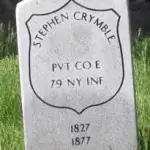
CRYMBLE, STEPHEN (1827-1877). Private, 79th New York Infantry, Company E. Crymble, who was born in Ireland, enlisted as a private on May 13, 1861, at New York City, and mustered into the 79th on May 28. On August 4, 1861, the New York Family Herald and the New York Tribune incorrectly listed him as among those killed and wounded at the Battle of Bull Run, Virginia. Subsequently, he was wounded at James Island, South Carolina, on June 16, 1862. After his arm was amputated, he was discharged for wounds on October 4 of that year. On April 9, 1863, his application for an invalid pension was granted under certificate 13,335.
On June 30, 1866, he became a naturalized citizen of the United States. According to the census of 1870, he was employed as a letter carrier. He is also listed as a letter carrier in the 1876-1878 New York City Directory. The Veterans Schedule of 1890 confirms his military service. He last lived at 330 East 39th Street in Manhattan. His death was caused by phthisis. Ellen Crymble applied for and received a widow’s pension, certificate 224,452. Section 15, lot 17263, grave 122.
CUDBIRTH, THOMAS C. (1845-1923). Private, 72nd New York Infantry, Company C; 120th New York Infantry, Company K. A New York City native, Cudbirth enlisted there as a private on August 25, 1862, and mustered immediately into the 72nd New York. He deserted on June 28, 1863, at Gettysburg, Pennsylvania. He re-enlisted as a private on June 23, 1864, and mustered into Company K of the 120th New York. He mustered out on June 3, 1865, at Washington, D.C.
The 1864 Jersey City and the 1870 New York City Directories list him as an agent; in 1870, he was living at 82 Charles Street in Manhattan. In 1909, he applied for and received a pension, certificate 1,159,058. He last lived in Point Pleasant, New Jersey. The cause of his death was uremia. As per a notice of his death in The New York Times, his funeral took place at Stephen Merritt’s Chapel at 223 Eighth Avenue at 21st Street in Manhattan. Section 64, lot 10170.
CULBERT, JAMES E. (1833-1879). Sergeant major, 42nd New York Infantry, Company A. A New York native, Culbert enlisted at Long Island, New York, as a sergeant, on June 22, 1861. On that date, he mustered into Company A of the 42nd New York and was promoted to sergeant major of his company on October 12, 1861. He was reduced in rank to private on August 15, 1862, before his discharge on an unknown date. He was a cousin of John Culbert (see). His last residence was in Middletown in Orange County, New York. Section 165, lot 17264.
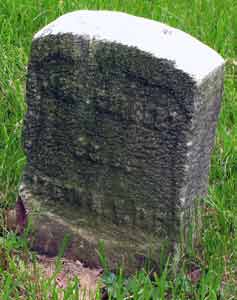
CULBERT, JOHN ANDREW (1844-1892). Private, 176th New York Infantry, Company D. A native New Yorker, Culbert was 5′ 7½” tall with blue eyes, brown hair and a light complexion. During the Civil War, he enlisted as a private on December 18, 1862, mustered into the 176th New York, and mustered out at New York City on November 16, 1863.
As per the census of 1870, he was a brass finisher; the New York City Directories for 1875-1876, 1876-1878 and the 1880 census report that he worked as a porter. In 1889, his application for an invalid pension was granted at the rate of $30 per month, certificate 491,934. According to the documents in his pension file, he was hospitalized in St. Louis Hospital in New Orleans, Louisiana, in March 1863 but the surgeon who treated him had died and could not issue a statement. In addition, he was hospitalized from June 28-August 5, 1863, with intermittent fever. Culbert attested that he was treated for rheumatism and bronchitis and that those conditions plagued him after his service; comrades, physicians who had treated him after the War, and neighbors filed affidavits in support of his claim. At the time of his pension application, his medical record stated that he weighed only 100 pounds and was suffering from disease of the respiratory organs. On November 11, 1890, his wife wrote in a sworn statement that she could not leave her husband alone, that he coughed all night, and could not afford hired help. He was a cousin of James Culbert (see). At the time of his death, he lived at 21 West 122nd Street in Manhattan. His widow received a pension in 1892, certificate 364,740. Section 165, lot 17264.